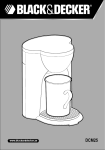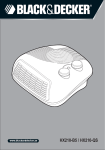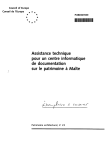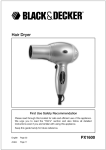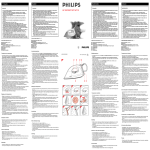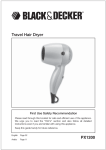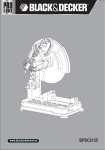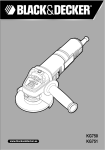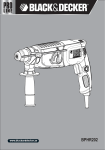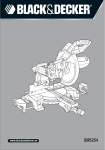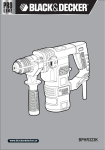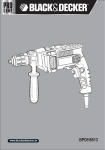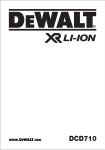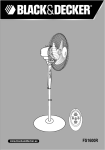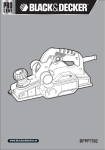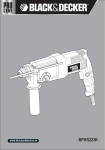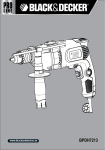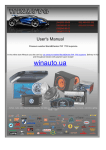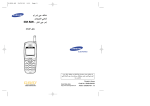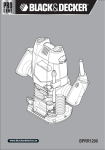Download Anglaise - Arabe
Transcript
www.blackanddecker.ae BPGL2223 ENGLISH 2 1 4 3 A 3 6 20 7 5 B 2 C1 ENGLISH 10 10 8 8 6 7 9 6 7 10 8 6 7 C2 C3 3 10 90o 11 10 4 D E 3 ENGLISH 15o-30o F G 4 A B ENGLISH Definitions: Safety Guidelines The definitions below describe the level of severity for each signal word. Please read the manual and pay attention to these symbols. Danger: Indicates an imminently hazardous situation which, if not avoided, will result in death or serious injury. Warning: Indicates a potentially hazardous situation which, if not avoided, could result in death or serious injury. Caution: Indicates a potentially hazardous situation which, if not avoided, may result in minor or moderate injury. Notice: Indicates a practice not related to personal injury which, if not avoided, may result in property damage. Denotes risk of electric shock. Denotes risk of fire. Warning: To reduce the risk of injury, read the instruction manual. General power tool safety warnings Warning! Read all safety warnings and all instructions. Failure to follow the warnings and instructions may result in electric shock, fire and/or serious injury. Save all warnings and instructions for future reference The term “power tool” in the warnings refers to your mains-operated (corded) power tool or battery-operated (cordless) power tool. 1) Work area safety a) Keep work area clean and well lit. Cluttered or dark areas invite accidents. b) Do not operate power tools in explosive atmospheres, such as in the presence of flammable liquids, gases or dust. Power tools create sparks which may ignite the dust or fumes. c) Keep children and bystanders away while operating a power tool. Distractions can cause you to lose control. 2) Electrical safety a) Power tool plugs must match the outlet. Never modify the plug in any way. Do not use any adapter plugs with earthed (grounded) power tools. Unmodified plugs and matching outlets will reduce risk of electric shock. b) Avoid body contact with earthed or grounded surfaces such as pipes, radiators, ranges and refrigerators. There is an increased risk of electric shock if your body is earthed or grounded. c) Do not expose power tools to rain or wet conditions. Water entering a power tool will increase the risk of electric shock. d) Do not abuse the cord. Never use the cord for carrying, pulling or unplugging the power tool. Keep cord away from heat, oil, sharp edges or moving parts. Damaged or entangled cords increase the risk of electric shock. e) When operating a power tool outdoors, use an extension cord suitable for outdoor use. Use of a cord suitable for outdoor use reduces the risk of electric shock. f) If operating a power tool in a damp location is unavoidable, use a residual current device (RCD) protected supply. Use of an RCD reduces the risk of electric shock. 3) Personal safety a) Stay alert, watch what you are doing and use common sense when operating a power tool. Do not use a power tool while you are tired or under the influence of drugs, alcohol or medication. A moment of inattention while operating power tools may result in serious personal injury. 5 ENGLISH b) Use personal protective equipment. Always wear eye protection. Protective equipment such as dust mask, non-skid safety shoes, hard hat, or hearing protection used for appropriate conditions will reduce personal injuries. c) Prevent unintentional starting. Ensure the switch is in the off position before connecting to power source and/or battery pack, picking up or carrying the tool. Carrying power tools with your finger on the switch or energising power tools that have the switch on invites accidents. d) Remove any adjusting key or wrench before turning the power tool on. A wrench or a key left attached to a rotating part of the power tool may result in personal injury. e) Do not overreach. Keep proper footing and balance at all times. This enables better control of the power tool in unexpected situations. f) Dress properly. Do not wear loose clothing or jewellery. Keep your hair, clothing and gloves away from moving parts. Loose clothes, jewellery or long hair can be caught in moving parts. g) If devices are provided for the connection of dust extraction and collection facilities, ensure these are connected and properly used. Use of dust collection can reduce dust-related hazards. 4) Power tool use and care a) Do not force the power tool. Use the correct power tool for your application. The correct power tool will do the job better and safer at the rate for which it was designed. b) Do not use the power tool if the switch does not turn it on and off. Any power tool that cannot be controlled with the switch is dangerous and must be repaired. c) Disconnect the plug from the power source and/or the battery pack from the power tool before making any adjustments, changing accessories, or storing power tools. Such preventive safety measures reduce the risk of starting the power tool accidentally. d) Store idle power tools out of the reach of children and do not allow persons unfamiliar with the power tool or these instructions to operate the power tool. Power tools are dangerous in the hands of untrained users. e) Maintain power tools. Check for misalignment or binding of moving parts, breakage of parts and any 6 other condition that may affect the power tool’s operation. If damaged, have the power tool repaired before use. Many accidents are caused by poorly maintained power tools. f) Keep cutting tools sharp and clean. Properly maintained cutting tools with sharp cutting edges are less likely to bind and are easier to control. g) Use the power tool, accessories and tool bits etc., in accordance with these instructions taking into account the working conditions and the work to be performed. Use of the power tool for operations different from those intended could result in a hazardous situation. 5) Service a) Have your power tool serviced by a qualified repair person using only identical replacement parts. This will ensure that the safety of the power tool is maintained. Additional specific safety rules Safety instructions for all operations Safety warnings common for grinding a) This power tool is intended to function as a grinder. Read all safety warnings, instructions, illustrations and specifications provided with this power tool. Failure to follow all instructions listed below may result in electric shock, fire and/or serious injury. b) Operations such as cutting-off , sander, wire brush or polisher are not recommended to be performed with this power tool. Operations for which the power tool was not designed may create a hazard and cause personal injury. c) Do not use accessories which are not specifically designed and recommended by the tool manufacturer. Just because the accessory can be attached to your power tool, it does not assure safe operation. d) The rated speed of the accessory must be at least equal to the maximum speed marked on the power tool. Accessories running faster than their rated speed can break and fly apart. e) The outside diameter and the thickness of your accessory must be within the capacity rating of your power tool. Incorrectly sized accessories cannon be adequately guarded or controlled. ENGLISH f) The arbour size of wheels, flanges, backing pads or any other accessory must properly fit the spindle of the power tool. Accessories with arbour holes that do not match the mounting hardware of the power tool will run out of balance, vibrate excessively and may cause loss of control. g) Do not use a damaged accessory. Before each use inspect the accessory such as abrasive wheel for chips and cracks, backing pad for cracks, tear or excess wear, wire brush for loose or cracked wires. If power tool or accessory is dropped, inspect for damage or install an undamaged accessory. After inspecting and installing an accessory, position yourself and bystanders away from the plane of the rotating accessory and run the power tool at maximum no-load speed for one minute. Damaged accessories will normally break apart during this test time. h) Wear personal protective equipment. Depending on application, use face shield, safety goggles or safety glasses. As appropriate, wear dust mask, hearing protectors, gloves and workshop apron capable of stopping small abrasive or workpiece fragments. The eye protection must be capable of stopping flying debris generated by various operations. The dust mask or respirator must be capable of filtrating particles generated by your operation. Prolonged exposure to high intensity noise may cause hearing loss. i) Keep bystanders a safe distance away from work area. Anyone entering the work area must wear personal protective equipment. Fragments of workpiece or of a broken accessory may fly away and cause injury beyond immediate area of operation. j) Hold the power tool by insulated gripping surfaces only, when performing an operation where the cutting accessory may contact hidden wiring or its own cord. Cutting accessory contacting a “live” wire may make exposed metal parts of the power tool “live” and could give the operator an electric shock. k) Position the cord clear of the spinning accessory. If you lose control, the cord may be cut or snagged and your hand or arm may be pulled into the spinning accessory. l) Never lay the power tool down until the accessory has come to a complete stop. The spinning accessory may grab the surface and pull the power tool out of your control. m) Do not run the power tool while carrying it at your side. Accidental contact with the spinning accessory could snag your clothing, pulling the accessory into your body. n) Regularly clean the power tool’s air vents. The motor’s fan will draw the dust inside the housing and excessive accumulation of powdered metal may cause electrical hazards. o) Do not operate the power tool near flammable materials. Sparks could ignite these materials. p) Do not use accessories that require liquid coolants. Using water or other liquid coolants may result in electrocution or shock. Further safety instructions for all operations Kickback and Related Warnings Kickback is a sudden reaction to a pinched or snagged rotating wheel, backing pad, brush or any other accessory. Pinching or snagging causes rapid stalling of the rotating accessory which in turn causes the uncontrolled power tool to be forced in the direction opposite of the accessory’s rotation at the point of the binding. For example, if an abrasive wheel is snagged or pinched by the workpiece, the edge of the wheel that is entering into the pinch point can dig into the surface of the material causing the wheel to climb out or kick out. The wheel may either jump toward or away from the operator, depending on direction of the wheel’s movement at the point of pinching. Abrasive wheels may also break under these conditions. Kickback is the result of tool misuse and/or incorrect operating procedures or conditions and can be avoided by taking proper precautions as given below: a) Maintain a firm grip on the power tool and position your body and arm to allow you to resist kickback forces. Always use auxiliary handle, if provided, for maximum control over kickback or torque reaction during start up. The operator can control torque reaction or kickback forces, if proper precautions are taken. b) Never place your hand near the rotating accessory. Accessory may kickback over your hand. c) Do not position your body in the area where power tool will move if kickback occurs. Kickback will propel the tool in direction opposite to the wheel’s movement at the point of snagging. d) Use special care when working corners, sharp edges etc. Avoid bouncing and snagging the accessory. Corners, sharp edges or bouncing have a tendency to snag the rotating accessory and cause loss of control or kickback. 7 ENGLISH e) Do not attach a saw chain woodcarving blade or toothed saw blade. Such blades create frequent kickback and loss of control. Labels on tool The label on your tool may include the following symbols: Safety Warnings Specific for Grinding Operations Read Instructions Manual Use Eye Protection a) Use only wheel types that are recommended for your power tool and the specific guard designed for the selected wheel. Wheels for which the power tool was not designed cannot be adequately guarded and are unsafe. b) The guard must be securely attached to the power tool and positioned for maximum safety, so the least amount of wheel is exposed towards the operator. The guard helps to protect operator from broken wheel fragments and accidental contact with wheel and sparks that could ignite clothing. c) Wheels must be used only for recommended applications. For example: do not grind with the side of cut-off wheel. Abrasive cut-off wheels are intended for peripheral grinding, side forces applied to these wheels may cause them to shatter. d) Always use undamaged wheel flanges that are of correct size and shape for your selected wheel. Proper wheel flanges support the wheel thus reducing the possibility of wheel breakage. Flanges for cut-off wheels may be different from grinding wheel flanges. e) Do not use worn down wheels from larger power tools. Wheel intended for larger power tool is not suitable for the higher speed of a smaller tool and may burst. Residual Risks In spite of the application of the relevant safety regulations and the implementation of safety devices, certain residual risks cannot be avoided. These are: – Impairment of hearing – Risk of personal injury due flying particles. – Risk of burns due to accessories becoming hot during operation. W ........ Watts min ..... minutes ..... Alternating Current Use Ear Protection V ........ Volts A ........ Amperes ..... Direct Current ...... Class II Construction .... Earthing Terminal .... Safety Alert Symbol .../min.. Revolutions or Reciprocation per minute n 0 ....... No-Load Speed Position of date barcode The Date Code, which also includes the year of manufacture, is printed into the housing. Example: 2014 XX JN Year of manufacturing Package Content This product package includes: 1 Angle grinder 1 Guard 1 Flange set 1 Spanner 1 Handle 1 Instruction manual • Check the tool, parts, and accessories to see if they are damaged during transportation. • Take a few moments to read and understand this manual before using the tool. Description (Fig. 1) Warning: Never modify the power tool or any part of the tool, otherwise it may cause damage to the tool or result in personal injury. – Risk of personal injury due to prolonged use. a. ON/OFF switch – Risk of dust from hazardous substances. b. Spindle lock c. Guard 8 Hz ....... Hertz ENGLISH Purpose of design Attaching the guard This angle grinder is designed especially for grinding. 1. Place the angle grinder on a work bench, groove facing up. Do not use sandpaper discs and grinding wheels other than those with depressed center. Do not use the tool in wet conditions or environments in the presence of flammable liquids or gases. 2. Bring the flange of the guard (3) collar over the groove (11) of the gear housing. 3. Turn the guard (4) counterclockwise by 150 degrees. This heavy-duty angle grinder is a professional power tool. 4. Make sure that the screws (20) are tightened. Do not allow children to come in contact with this tool. Inexperienced operators are required to use this tool under supervision. Removing the guard Electrical Equipment Safety 2. Pull up the guard (3). Only one voltage is applicable to this tool. Be sure to check that the power suuply corresponds to the voltage on the rating plate. Your Black & Decker tool is equipped with double insulation, hence, it does not require to be earthed. When the power cord is damaged, have it sent to a Black & Decker service center for replacement to specially prepared cables. Using Extension Cords If an extension cord is required, please select a 3-phase extension cord that has been inspected and matches the input power (see Technical Data) of this tool. The minimum conductor size is 1.5mm2, maximum length is 30 meters. When using a cable reel, be sure to pull out all the cables. Assembly and Adjustment Warning: To minimize the danger of serious personal injury, please switch off the tool power and disconnect all plugs before adjusting or removing/installing any accessory. Before reassembling the tool, press and release the trigger switch to make sure the tool is already switched off. Attaching and Removing the Wheel Guard (Fig. B) Warning To minimize the danger of serious personal injury, please switch off the tool power and disconnect all plugs before adjusting or removing/installing any accessory. Before reassembling the tool, press and release the trigger switch to make sure the tool is already switched off. 1. Loosen the screws (20) on the guard collar. Warning: Do not operate the tool when the safety guard is not in place. Fitting and removing a grinding (Fig. C1, C2, C3) Warning: Do not use damaged grinding wheels. 1. Place the tool on a work bench, guard up. 2. Fit the inner flange (6) correctly onto the spindle (7) (Fig. C1). 3. Place the disc (8) on the flange (6) (Fig.C2). When fitting a disc with a raised center, make sure that the raised centre (9) is facing the flange (6). 4. Screw the out flange (10) onto the spindle (7) (Fig. C3) - the ring on the flange (10) must fae towoards the disc when fitting a grinding disc (A) - the ring on the flange (10) must face away from the disc when fitting a cutting disc (B) 5. Press the spindle lock (2) and rotate the spindle (7) until it locks in position (Fig. C2). 6. Tighten the flange (10) with the two-pin spanner supplied. 7. Release the spindle lock. 8. To remove the disc, loosen the flange (10) with the two-pin spanner. Warning: Do not use a damaged disc. 9 ENGLISH Mounting the side handle (Fig.D) • For grinding, screw the side handle (4) tightly into one of the holes (11) or (12) on either side of the gear case. Preparation Before Use • Attach the safety guard and appropriate abrasive or grinding wheels. Do not use abrasive or grinding wheels that are overly worn. • Make sure that the inner and outer flanges are attached correctly. • Make sure that the abrasive or grinding wheels are rotating in the direction of the arrows on the accessories and tool. Operation (Fig. F) Instructions Warning: Always observe the safety instructions and applicable regulations. Warning: To minimize the danger of serious personal injury, please switch off the tool power and disconnect all plugs before adjusting or removing/installing any accessory. Before reassembling the tool, press and release the trigger switch to make sure the tool is already switched off. Warning: • Make sure all materials to be grinded are secured in position. • Apply slight pressure to the tool. Do not apply side pressure to the abrasive disc. • Avoid overloading. If the tool becomes hot, let it spin for a few minutes with no load. 1. Be sure to hold the tool tightly with both hands (one hand on housing, the other on side handle). Start the tool and bring the grinding wheel on the workpiece. 2. Keep the edge of the wheel tilted at angle from 15 to 30 degrees against the surface of the workpiece. 3. When using a new grinding wheel, do not operate the wheel in the B direction, otherwise, it will cut into the workpiece. When the edge of wheel has been rounded off, you are free to operate the grinder in either the A or B direction. 10 Starting and Stopping (Fig. A) Warning: Before using the tool, check whether the handle is tightened securely. Check whether the ON/OFF switch is working normally. Before plugging in the tool to the power supply, check whether the switch is in the OFF position when pressing the rear end of the switch. To start the tool, press the rear end of the switch and slide it forward. Then press the front end of the switch to lock it. Press the rear end of the switch to stop the tool. Warning: Do not switch the tool on or off while under load conditions. Proper Hand Position (Fig. G) Warning: To reduce the risk of serious personal injury, ALWAYS use proper hand position as shown. Warning: To reduce the risk of serious personal injury, ALWAYS hold securely in anticipation of a sudden reaction. Proper hand position requires one hand on the side handle (figure A), with the other hand on the body of the tool, as shown in figure G. Switches Caution: Hold the body of the tool firmly to maintain control of the tool at start up and during use and until the wheel or accessory stops rotating. Make sure the wheel has come to a complete stop be fore laying the tool down. Note: To reduce unexpected tool movement, do not switch the tool on or off while under load conditions. Allow the grinder to run up to full speed before touching the work surface. Lift the tool from the surface before turning the tool off. Allow the tool to stop rotating before putting it down. ON/OFF switch (1) with auto-lock(Fig. A) Warning: Before connecting the tool to a power supply, be sure the slider switch is in the off position by pressing the front part of the switch and releasing. Ensure the slider switch is in the off position as described above after any interruption in power supply to the tool, such as the activation of a ground fault interrupter, throwing of a circuit breaker, accidental unplugging, or power failure. If the slider switch is locked on when the power is connected, the tool will start unexpectedly. ENGLISH To start the tool, slide the slider switch 1 toward the front of the tool and press, the tool will keep running. Release pressure from the switch and the tool will stop. To avoid accumulation of metal chips in the interior of the grinder, we recommend cleaning the ventilation ducts daily. Refer to Maintenance. Lock feature of the ON/OFF switch Using Grinding Wheels Slide slider switch 1 to the front of the tool and press, and the tool will start. When releasing the switch, keep the switch pressed down and push it to the front of the tool, and the tool will keep running. To turn off the tool, press the front portion of the switch to release it. The switch will spring up, which means that the tool is in the off-state. Warning: Metal powder accumulates. Excessive use of the grinding wheel on metals may increase the risk of electric shock. To reduce the risk, insert the RCD before use and clean the ventilation ducts daily. Follow the maintenance instructions below to blow dry compressed air into the ventilation ducts. Explanation: Before coming into contact with the object you are working on, make sure the abrasive wheel is turning at maximum speed. Before turning off the tool, lift the tool up from the object you are working on. Maintenance Caution: Make sure the abrasive wheel is completely stopped before putting down the tool. Rotating the Gear Case (fig. E) The gear case is mounted onto the tool casing, and it can be rotated to give the user a more comfortable experience while cutting. The rotating gear case can be turned 90 degrees, 180 degrees, and 270 degrees to the left or to the right. Black & Decker power tools have been designed to operate over a long period of time with minimal maintenance. Continuous satisfactory operation depends upon proper tool care and regular cleaning. Warning: To minimize the danger of serious personal injury, please switch off the tool power and disconnect all plugs before adjusting or removing/installing any accessory. Before reassembling the tool, press and release the trigger switch to make sure the tool is already switched off. • Loosen the four screws on the gear case. • Rotate the gear case till it reaches its ideal location. Lubrication • Tighten the four screws on the gear case. This power tool does not require separate lubrication. • Ensure that the rotating mechanism is locked. Warning: Do NOT use the tool when the gear case is unlocked. Application on Metals When applying the tool on metals, make sure that a residual-current device (RCD) is inserted to prevent danger from metal chips. If the RCD causes power disconnection, have the tool sent to an authorized Black & Decker dealer for repair. Warning: Under extreme working conditions, conductive dust and grit may accumulate on the housing interior when handling metal workpieces. This could create an electric shock hazard as it weakens the protective insulation in the grinder. Cleaning Warning: Once visible dust accumulates on the ventilation ducts and the surrounding, immediately use dry air to blow away dust and grit out of the interior of the housing. You need to wear approved eye and facial protective gear when performing this process. Warning: Never use solvents or harsh chemicals to clean non-metal parts of the tool. These chemicals may weaken the material of the parts. Use only mild soap and damp cloth to clean the tool. Never let any liquid get inside the tool; never immerse any part of the tool into liquid. 11 ENGLISH Accessories Protecting the environment Warning: Excluding accessories provided by Black & Decker, all other accessories have not been tested for product compatibility. Using such accessories together with this tool may cause safety hazards. To minimize the risk of personal injury, we recommend you to use only Black & Decker accessories with this product. Please inquire at your dealer for more information regarding suitable accessories. Remarks • Black & Decker's policy is one of continuous improvement to our products and as such, we reserve the right to modify product specifications without prior notice. • Standard equipment and accessories may vary by country. • Product specifications may differ by country. • Complete product range may not be available in all countries. Contact your local Black & Decker dealers for range availability. Specifications BPGL2223 Input power W 2200 min-1 6500 Wheel diameter mm 230 Grindig wheels thickness mm 6.6 No-load speed/rated speed Type of wheel 27 Spindle diameter Weight 12 M14 kg 6 Separate collection. This product must not be disposed of with normal household waste. Should you find one day that your Black & Decker product needs replacement, or if it is of no further use to you, do not dispose of it with household waste. Make this product available for separate collection. Separate collection of used products and packaging allows materials to be recycled and used again. Reuse of recycled materials helps prevent environmental pollution and reduces the demand for raw materials. Local regulations may provide for separate collection of electrical products from the household, at municipal waste sites or by the retailer when you purchase a new product. Black & Decker provides a facility for the collection and recycling of Black & Decker products once they have reached the end of their working life. To take advantage of this service please return your product to any authorised repair agent who will collect them on our behalf. You can check the location of your nearest authorised repair agent by contacting your local Black & Decker office at the address indicated in this manual. Alternatively, a list of authorised Black & Decker repair agents and full details of our after-sales service and contacts are available on the Internet at: www.2helpU.com. ENGLISH Guarantee Black & Decker is confident of the quality of its products and offers an outstanding guarantee. This guarantee statement is in addition to and in no way prejudices your statutory rights. The guarantee is valid within the territories of the Member States of the European Union and the European Free Trade Area. If a Black & Decker product becomes defective due to faulty materials, workmanship or lack of conformity, within 12 months from the date of purchase, Black & Decker guarantees to replace defective parts, repair products subjected to fair wear and tear or replace such products to make sure of the minimum inconvenience to the customer unless: The product has been used for trade, professional or hire purposes. The product has been subjected to misuse or neglect. The product has sustained damage through foreign objects, substances or accidents. Repairs have been attempted by persons other than authorised repair agents or Black & Decker service staff. To claim on the guarantee, you will need to submit proof of purchase to the seller or an authorised repair agent. You can check the location of your nearest authorised repair agent by contacting your local Black & Decker office at the address indicated in this manual. Alternatively, a list of authorised Black & Decker repair agents and full details of our aftersales service and contacts are available on the Internet at: www.2helpU.com Please visit our website www.blackanddecker.co.uk to register your new Black & Decker product and to be kept up to date on new products and special offers. Further information on the Black & Decker brand and our range of products is available at www.blackanddecker.co.uk. 13 FRANÇAIS 2 1 4 3 A 3 6 20 7 5 B 14 C1 FRANÇAIS 10 10 8 8 6 7 9 6 7 10 8 6 7 C2 C3 3 10 90o 11 10 4 D E 15 FRANÇAIS 15o-30o F G 16 A B FRANÇAIS Définitions: Consignes de sécurité Les définitions données ci-dessous décrivent le niveau de gravité pour chaque symbole. Veuillez lire ce manuel et prêter attention à ces symboles. Danger: Indique une situation extrêmement dangereuse qui, si elle n’est pas évitée, aura pour conséquence des blessures corporelles graves ou mortelles. Attention : Indique une situation potentiellement dangereuse qui, si elle n’est pas évitée, aura pour conséquence des blessures corporelles graves ou mortelles. Avertissement : Indique une situation potentiellement dangereuse qui, si elle n’est pas évitée, aura pour conséquence des blessures corporelles légères ou de gravité modérée. Avis : Indique une pratique non reliée à des blessures corporelles qui, si elle n’est pas évitée, aura pour conséquence des dommages matériels. Indique un risque de choc électrique. Indique un risque d’incendie. Attention : Pour réduire le risque de blessures corporelles, lire ce manuel d’instructions. Consignes de sécurité concernant les outils électroportatifs Attention ! Lisez avec attention tous les avertissements et toutes les instructions. Le non-respect de cette consigne peut entraîner une électrocution, un incendie et/ou de graves blessures. Conservez tous les avertissements et instructions pour référence ultérieure. La notion d'« outil électroportatif » mentionnée par la suite se rapporte à des outils électriques raccordés au secteur (avec câble de raccordement) ou fonctionnant avec batterie (sans fil). 1. Sécurité de la zone de travail a. Maintenez la zone de travail propre et bien éclairée. Un lieu de travail en désordre ou mal éclairé augmente le risque d'accidents. b. N'utilisez pas les outils électroportatifs dans un environnement présentant des risques d'explosion ni en présence de liquides, gaz ou poussières inflammables. Les outils électroportatifs génèrent des étincelles risquant d'enflammer les poussières ou les vapeurs. c. Pendant l’utilisation d’un outil électroportatif, les enfants et autres personnes doivent rester éloignés. En cas d'inattention, vous risquez de perdre le contrôle de l'outil. 2. Sécurité électrique a. La prise de l'outil électroportatif doit convenir à la prise de courant. Ne modifiez en aucun cas la prise. N'utilisez pas de prises d'adaptateur avec des appareils ayant une prise de terre. Le respect de ces consignes réduit le risque de choc électrique. b. Évitez le contact physique avec des surfaces mises à la terre telles que tuyaux, radiateurs, fours et réfrigérateurs. Le risque de choc électrique augmente si votre corps est relié à la terre. c. N'exposez pas l'outil électroportatif à la pluie ni à l'humidité. La pénétration d'eau dans un outil électroportatif augmente le risque de choc électrique. d. Préservez le câble d'alimentation. N'utilisez pas le câble pour porter l'outil, pour l'accrocher ou encore pour le débrancher. Maintenez le câble éloigné des sources de chaleurs, des parties huilées, des bords tranchants ou des parties de l'appareil en rotation. Le risque de choc électrique augmente si les câbles sont endommagés ou emmêlés. e. Si vous utilisez l'outil électroportatif à l'extérieur, utilisez une rallonge homologuée pour utilisation à l'air libre. L'utilisation d'une rallonge électrique homologuée pour les travaux à l’extérieur réduit le risque de choc électrique. f. Si l’outil doit être utilisé dans un endroit humide, prenez les précautions nécessaires en utilisant un dispositif à courant résiduel (RCD). L’utilisation d’un tel dispositif réduit les risques d’électrocution. 3. Sécurité personnelle a. Restez vigilant, surveillez ce que vous faites. Faites preuve de bon sens quand vous utilisez un outil électroportatif. N’utilisez pas l’outil lorsque vous êtes fatigué ou après avoir consommé de l’alcool ainsi que des médicaments. Un moment d'inattention lors de l'utilisation de l'outil peut entraîner de graves blessures. 17 FRANÇAIS b. Portez un équipement de protection. Portez toujours des lunettes de protection. Selon le travail à effectuer, le port d'équipement de protection tels que masque anti-poussières, chaussures de sécurité antidérapantes, casque ou protection auditive, réduit le risque de blessures. e. Prenez soin des outils électroportatifs. Vérifiez que les parties en mouvement fonctionnent correctement et qu'elles ne sont pas coincées. Vérifiez qu'il n’y a pas de pièces cassées ou endommagées susceptibles de nuire au bon fonctionnement de l'outil. S’il est endommagé, faites réparer l’outil avant de l’utiliser. De nombreux accidents sont la conséquence d’outils mal entretenus. c. Évitez un démarrage imprévu. L’appareil doit être en position OFF (arrêt) avant d'effectuer le branchement à l'alimentation et/ou au bloc-batterie, de le ramasser f. Maintenez les outils de coupe aiguisés et propres. ou de le porter. Ne laissez pas votre doigt sur le bouton Des outils soigneusement entretenus avec des bords de commande, ceci peut être à l’origine d’accident. tranchants bien aiguisés se coincent moins souvent et peuvent être guidés plus facilement. d. Retirez tout outil ou clé de réglage avant de mettre l’outil en marche. Une clé ou un outil se trouvant sur g. Utilisez les outils électroportatifs, les accessoires, une partie en rotation peut causer des blessures. etc. en suivant ces instructions et en tenant compte des conditions de travail, ainsi que du travail à e. Adoptez une position confortable. Adoptez une effectuer. L'utilisation des outils électroportatifs à d'autres position stable et gardez votre équilibre en fins que celles prévues peut vous mettre en situation permanence. Vous contrôlerez ainsi mieux l'outil dans dangereuse. des situations inattendues. 5. Réparations f. Portez des vêtements appropriés. Ne pas porter de vêtements flottants ou de bijoux. N’approchez pas a. Faites réparer votre outil électroportatif uniquement les cheveux, vêtements ou gants des parties des par du personnel qualifié et seulement avec des pièces mobiles. Les vêtements amples, les bijoux ou pièces de rechange appropriées. La fiabilité de l’outil les cheveux longs peuvent être attrapés dans les pièces sera ainsi maintenue. en mouvement. g. En cas d’utilisation d’appareils servant à aspirer ou à recueillir les poussières, assurez-vous qu’ils sont correctement raccordés et utilisés. L'utilisation de tels appareils permet de réduire les dangers liés aux poussières. 4. Utilisation des outils électroportatifs et précautions a. Respectez la capacité de l'outil. Utilisez l'outil électroportatif approprié pour le travail à effectuer. Avec un outil approprié, vous travaillerez mieux et en toute sécurité. b. N’utilisez pas un outil électroportatif dont l’interrupteur marche/arrêt est défectueux. Un outil électroportatif qui ne peut plus être mis en marche ou arrêter est dangereux et doit être réparé. c. Retirez la prise de courant et/ou débranchez le blocbatterie avant d'effectuer des réglages, de changer les accessoires ou de ranger l'outil. Cette mesure de précaution empêche de mettre l’outil en marche accidentellement. d. Rangez les outils électroportatifs hors de portée des enfants. Les personnes ne connaissant pas l’outil ou n’ayant pas lu ces instructions ne doivent en aucun cas l’utiliser. Les outils électroportatifs sont dangereux lorsqu'ils sont utilisés par des personnes non initiées. 18 Consignes de sécurité spécifiques supplémentaires Consignes de sécurité pour l’ensemble des opérations Consignes de sécurité courants pour le meulage a) Cet outil électrique est conçu pour être utilisé comme meuleuse. Lire avec attention tous les avertissements, les instructions, les illustrations et les spécifications données avec cet outil. Le non-respect des instructions indiquées ci-dessous peut entraîner un choc électrique, un incendie et/ou de graves blessures. b) Cet outil n’est pas recommandé pour des opérations telles que scier, poncer, nettoyer avec une brosse métallique ou polir. L’utilisation à d’autres fins que celles prévues présente un danger et peut causer des blessures graves. c) Seuls les accessoires spécialement conçus et recommandés par le fabricant doivent être utilisés. Même si un accessoire peut être fixé à l’outil, cela ne signifie pas que votre outil fonctionnera en toute sécurité. d) La vitesse nominale des accessoires doit être au moins égale à la vitesse maximale inscrite sur l’outil. Les accessoires dont la rotation est plus rapide que la vitesse nominale peuvent se briser et éclater en plusieurs morceaux. FRANÇAIS e) Le diamètre extérieur et l’épaisseur de votre accessoire doivent correspondre à la capacité nominale de votre outil. Il est impossible de garantir la protection ou le contrôle des accessoires de dimension incorrecte. f) La dimension de l’alésage central des disques, des flasques, du plateau porte-disques ou d’autres accessoires doit correspondre exactement à l’axe de l’outil. Les accessoires dont l’alésage central ne correspond pas au matériel de fixation de l’outil peuvent être difficiles à contrôler. Le niveau de vibrations peut augmenter et provoquer la perte du contrôle de l’outil. g) N’utilisez pas d’accessoires endommagés. Avant chaque utilisation, vérifiez l’état des accessoires et la présence de défauts ou de fissures sur le disque abrasif, de fissures ou une usure excessive sur le plateau porte-disque, de poils de brosse métallique endommagés. Si l’outil ou l’accessoire tombe, vérifiez l’état et le cas échéant, installez un accessoire en bon état. Après la vérification et l’installation d’un accessoire, placez-vous et les observateurs à distance du plan de rotation de l’accessoire et mettez l’outil en marche à vitesse à vide maximale pendant une minute. En général un accessoire endommagé ne résistera pas au cours de cette période d’essai. h) i) j) k) l) Ne posez pas l’outil avant l’arrêt complet de l’accessoire. L’accessoire en rotation peut s’accrocher à la surface et vous faire perdre son contrôle. m) Ne mettez pas l’appareil en marche lorsque vous le transportez. L’accessoire en rotation peut attraper vos vêtements et vous blesser. n) Nettoyez régulièrement les aérations de l’outil. Le ventilateur du moteur entraîne la poussière à l’intérieur de l’outil et une accumulation excessive de poudre de métal peut causer des accidents liés à l’électricité. o) Ne faites pas fonctionner l’outil dans un environnement proche de matériaux inflammables. Les étincelles risquent d’enflammer ces matériaux. p) N’utilisez pas d’accessoires nécessitant un liquide de refroidissement. L’utilisation d’eau ou d’un autre liquide de refroidissement peut entraîner un choc électrique ou une électrocution. Consignes de sécurité supplémentaires pour tout type d’opérations Effet de retour et avertissements L’effet de retour est une réaction soudaine d’un disque en rotation, d’un plateau porte-disque, d’une brosse ou de tout autre accessoire coincé ou accroché. Ce genre de problème Portez un équipement de protection. En fonction du arrête rapidement l’accessoire en rotation. L’outil devient travail à exécuter, utilisez un masque ou des lunettes alors incontrôlable et est entraîné en direction inverse de la de protection. Le cas échéant, portez un masque rotation. anti-poussière, des protections auditives, des gants et un tablier de travail afin de vous protéger des Par exemple, si un disque abrasif est accroché ou coincé par éventuels éclats. La protection oculaire doit être la pièce, le bord du disque qui se trouve au point de suffisamment efficace pour protéger vos yeux contre les pincement peut creuser la surface du matériau provoquant projections de débris générés par diverses opérations. un dégagement du disque. Le disque peut être éjecté vers En portant un masque anti-poussière, vous éviterez de l’utilisateur ou à l’opposé, selon la direction du mouvement respirer les particules créées pendant le travail. Une du disque au point de pincement. Les disques abrasifs exposition prolongée aux bruits trop puissants peut peuvent aussi se casser dans ce type de situation. entrainer la perte de l’ouïe. L’effet de retour est le résultat d’une utilisation inappropriée Pour le maintien de la sécurité, éloignez les de l’outil voire de procédures ou de conditions d’utilisation. personnes autour de la zone de travail. Toute Ceci peut être évité en appliquant les précautions adéquates, personne entrant dans la zone de travail doit porter décrites ci-après: un équipement de protection. Des éclats de pièces ou a) En maintenant fermement l’outil, placez votre corps d’un accessoire cassé peuvent être projetés au-delà de et votre bras de manière à pouvoir résister à la la zone de travail et causer des blessures. puissance d’un retour. Utilisez toujours la poignée Tenez l’outil uniquement au niveau des surfaces de auxiliaire, quand elle existe, pour contrôler au maximum le retour ou la réaction du couple au prise isolées. Ceci permet d’éviter les accidents en démarrage. L’utilisateur a la possibilité de contrôler les cas de contact de l’accessoire de coupe avec des réactions de couple ou les forces de retour lorsque les fils cachés ou son propre câble. En touchant un fil précautions nécessaires sont prises. sous tension, la charge électrique passe dans les parties métalliques de l’outil électroportatif et il y a risque de b) Ne placez jamais votre main à côté de l’accessoire en choc électrique. rotation. L’accessoire peut rebondir sur votre main. Eloignez le câble des accessoires en rotation. Si c) Ne vous placez pas dans la zone de déplacement de vous perdez le contrôle, le câble peut être coupé ou l’outil dans le cas où un effet de retour se produirait. détérioré et votre main ou votre bras peut se trouver L’effet de retour pousse l’outil dans la direction opposée entrainé dans l’accessoire en rotation. au mouvement du disque au point d’accrochage. 19 FRANÇAIS d) Prenez les précautions nécessaires pour travailler dans les coins, les arêtes vives, etc. évitez de coincer ou de faire rebondir l’accessoire. Les coins, les arêtes vives ou les à-coups ont tendance à coincer l’accessoire en rotation et à causer la perte de contrôle ou un effet de retour. Etiquettes de l’outil L’étiquette apposée sur l’outil peut afficher les symboles suivants: Hz ....... Lire le manuel d’instructions W ....... e) Ne montez pas sur l’outil une lame de scie dentée ou à chantourner. Ce genre de lames crée fréquemment un effet de retour et la perte de contrôle. Conseils de sécurité spécifiques pour les opérations de meulage a) N’utilisez que les types de disque recommandés pour votre outil et la protection spécifique au disque sélectionné. Les disques destinés à d’autres outils ne peuvent être protégés correctement et par conséquent sont dangereux. b) La protection doit être correctement fixée à l’outil, en exposant le disque le moins possible vers l’utilisateur pour le protéger au maximum. La protection permet de protéger l’utilisateur des éclats, d’un contact accidentel avec le disque et des étincelles qui pourraient enflammer les vêtements. c) Les disques ne doivent être utilisés que pour les applications recommandées. Par exemple: ne meulez pas avec le côté du disque de coupe. Les disques abrasifs sont destinés au meulage périphérique, des forces latérales auraient pour conséquence de les briser. Utiliser une protection oculaire A ........ Ampères Watts min ..... minutes ..... Courant alternatif ..... Courant continu Utiliser des protections auditives V ........ Volts ...... Construction de classe II Hertz ...... Borne de terre ...... .../min.. Symbole d’alerte de sécurité Rotations par minute n0 ....... Vitesse à vide Emplacement du code barre de la date Le code barre de la date, comprenant aussi l’année de fabrication, est imprimé sur le boîtier de l’outil. Exemple: 2014 XX JN Année de fabrication Contenu de la boîte La boîte de cet outil contient: 1 Meuleuse d’angle d) N’utilisez que des flasques en bon état, de dimension et de forme appropriées à votre disque. 1 Carter de protection Les flasques de disque appropriés soutiennent le disque, 1 Jeu de brides ce qui limite le risque de casse. Les flasques de disque de coupe peuvent être différents de ceux de disque de 1 Clé meulage. 1 Poignée e) N’utilisez pas de disques usés pris sur des meuleuses plus grandes. Les disques destinés aux 1 Manuel d’instructions grandes meuleuses ne sont pas adaptés aux vitesses rapides des petites meuleuses et peuvent se décrocher. • Contrôlez visuellement l’outil, les pièces et les accessoires pour vérifier qu’ils n’ont pas été endommagés pendant le transport. Risques résiduels Même en respectant les consignes de sécurité applicables et en utilisant des dispositifs de sécurité, certains risques résiduels ne peuvent pas être évités. Sont inclus : – Troubles auditifs – Blessures causées par la projection d’éclats. – Brûlures causées par les accessoires devenant chauds pendant l’utilisation. • Prenez quelques instants pour lire et assimiler les instructions données dans ce manuel avant d’utiliser cet outil. Description (Fig. 1) Attention: Ne modifiez jamais un outil électrique ou une partie de l’outil, cela pourrait l’endommager et entraîner des blessures corporelles. a. Interrupteur Marche/Arrêt – Blessures causées par l’utilisation prolongée d’un outil. b. Blocage de l’axe – Poussières contenant des substances nocives. 20 c. Carter de protection FRANÇAIS Objectif de conception Installation du carter de protection Cette meuleuse d’angle est conçue spécialement pour le meulage. 1. Placez la meuleuse d’angle sur un banc de travail, rainure vers le haut. N’utilisez pas de disques abrasifs ou de meulage autres que ceux dont le centre est incurvé. 2. Alignez le flasque de la collerette du carter (3) sur la rainure (11) du boîtier d’engrenage. N’utilisez pas l’outil dans un milieu humide ou à proximité de liquides ou de gaz inflammables. 3. Faites pivoter le carter (4) dans le sens antihoraire de 150 degrés. Cette meuleuse d’angle ultra robuste est un outil électrique professionnel. 4. Assurez-vous que les vis (20) sont serrées. Ne laissez pas les enfants manipuler cet outil. Les opérateurs inexpérimentés doivent être surveillés lorsqu’ils utilisent cet outil. Sécurité électrique des équipements Retrait du carte de protection 1. Desserrez les vis (20) sur la collerette du carter. 2. Retirez le carter de protection (3). Attention! Ne faites pas fonctionner l’outil sans le carter de protection en place. Le moteur électrique a été conçu pour une tension spécifique. Vérifiez toujours que la tension secteur Installation et retrait du disque de meulage correspond à celle indiquée sur la plaque signalétique. Votre outil Black & Decker est doublement isolé (Fig. C1, C2, C3) et de ce fait, ne nécessite pas un branchement à la terre. Attention! N’utilisez pas de disques endommagés. Lorsque le câble d’alimentation est endommagé, envoyez-le 1. Placez l’outil sur un banc de travail, carter de protection dans un centre de service Black & Decker pour qu’il soit vers le haut. remplacé par un câble spécialement préparé. Utilisation d’un cordon prolongateur Si l’utilisation d’un cordon prolongateur est nécessaire, veuillez utiliser une rallonge à 3 phases qui a été vérifiée et dont la puissance nominale correspond à l’outil (voir Données techniques). La taille minimale du conducteur est de 1,5mm2 avec une longueur maximale de 30 mètres. Si vous utilisez un enrouleur de câble, déroulez toujours le câble entièrement. Assemblage et réglage Attention! Pour minimiser le risque de blessures corporelles graves, veuillez éteindre et débrancher toutes les fiches avant de régler ou d’enlever/ajouter un accessoire. Avant de remonter l’outil, appuyez sur le déclencheur puis relâchez-le pour vous assurer que l’outil est bien éteint. Installation et retrait du carter de protection (Fig. B) Attention! Pour minimiser le risque de blessures corporelles graves, veuillez éteindre et débrancher toutes les fiches avant de régler ou d’enlever/ajouter un accessoire. Avant de remonter l’outil, appuyez sur le déclencheur puis relâchez-le pour vous assurer que l’outil est bien éteint. 2. Placez le flasque intérieur (6) correctement sur l’axe (7) (Fig. C1). 3. Placez le disque (8) sur le flasque (6) (Fig.C2). Lorsque vous installez un disque avec un centre relevé, assurez-vous que le centre relevé du disque (9) est orienté vers le flasque (6). 4. Vissez le flasque extérieur (10) sur l’axe (7) (Fig. C3) - l’anneau sur le flasque (10) doit être orienté vers le disque lorsque vous installez un disque de meulage (A) - l’anneau sur le flasque (10) doit être orienté à l’opposé du disque lorsque vous installez un disque de coupe (B) 5. Maintenez le blocage de l’axe (2) enfoncé et faites pivoter l’axe (7) jusqu’à ce qu’il s’enclenche en position (Fig. C2). 6. Serrez le flasque (10) avec la clé à deux ergots fournie. 7. Relâchez le blocage de l’axe. 8. Pour retirer le disque, desserrez le flasque (10) avec la clé à deux ergots. Attention: Ne pas utiliser un disque endommagé. 21 FRANÇAIS Installation de la poignée latérale (Fig.D) Mise en marche et arrêt (Fig. A) • Attention! Avant d’utiliser l’outil, vérifiez que la poignée est correctement serrée. Vérifiez que l’interrupteur Marche/Arrêt fonctionne normalement. Pour meuler, vissez fermement la poignée latérale (4) dans l’un des trous (11) ou (12) situés de chaque côté du boîtier d’engrenage. Préparation avant l’utilisation • Installez le carter de protection et les disques abrasifs ou de meulage appropriés. N’utilisez pas de disques abrasifs ou de meulage usés à l’excès. • Assurez-vous que les flasques intérieur et extérieur sont correctement installés. • Assurez-vous que les disques abrasifs ou de meulage tournent dans le sens des flèches présentes sur les accessoires et l’outil. Fonctionnement (Fig. F) Instructions Attention! Respectez toujours les consignes de sécurité et la réglementation en vigueur. Attention! Pour minimiser le risque de blessures corporelles graves, veuillez éteindre et débrancher toutes les fiches avant de régler ou d’enlever/ajouter un accessoire. Avant de remonter l’outil, appuyez sur le déclencheur puis relâchez-le pour vous assurer que l’outil est bien éteint. Attention: • Assurez-vous que tous les matériaux à meuler sont arrimés en place. • Appliquez une légère pression sur l’outil. N’exercez pas de pression latérale sur le disque de meulage. • Evitez de surcharger l’outil. Si l’outil devient chaud, laissez-le tourner à vide pendant quelques minutes. 1. Maintenez fermement l’outil avec vos deux mains (une main sur le boîtier, l’autre sur la poignée latérale). Mettez l’outil en marche et approchez le disque de la meuleuse sur la pièce à meuler. 2. Conservez un angle de 15 à 30 degrés entre le bord du disque et la surface de la pièce. 3. Lorsque vous utilisez un disque à meuler neuf, ne faites pas fonctionner le disque dans la direction B, sinon il risque de couper dans la pièce à meuler. Lorsque le bord du disque s’est arrondi, vous pouvez alors faire fonctionner le disque dans la direction A ou B. 22 Avant de brancher l’outil au secteur, vérifiez que l’interrupteur est bien en position Arrêt en appuyant sur l’extrémité arrière de l’interrupteur. Pour démarrer l’outil, appuyez sur l’extrémité arrière de l’interrupteur et faites-le glisser vers l’avant. Puis appuyez sur l’extrémité avant de l’interrupteur pour le verrouiller. Appuyez sur l’extrémité arrière de l’interrupteur pour arrêter l’outil. Attention! Ne mettez pas l’outil hors ou sous tension lorsqu’il est sous charge. Position correcte des mains (Fig. G) Attention! Pour réduire le risque de blessures corporelles graves, placez TOUJOURS vos mains correctement comme indiqué. Attention! Pour réduire le risque de blessures corporelles graves, maintenez TOUJOURS l’outil fermement en anticipation d’une réaction soudaine. Une position correcte des mains demande une main sur la poignée latérale (figure A), et l’autre main sur le corps de l’outil, comme le montre la figure G. Interrupteurs Avertissement: Maintenez fermement le corps de l’outil pour en garder le contrôle au démarrage et pendant son utilisation, et jusqu’à l’arrêt du disque ou d’un accessoire. Veillez à attendre l’arrêt complet avant de reposer l’outil. Remarque: Pour réduire le risque d’un mouvement inattendu de l’outil, ne le mettez pas hors ou sous tension pendant qu’il est sous charge. Laissez la meuleuse atteindre sa pleine vitesse avant de toucher la surface à meuler. Soulevez l’outil de la pièce avant de l’éteindre. Attendre l’arrêt complet de l’outil avant de le poser. Interrupteur Marche/Arrêt (1) avec verrouillage automatique (Fig. A) Attention! Avant de brancher l’outil au secteur, vérifiez que l’interrupteur à glissière est bien en position arrêt en appuyant sur l’extrémité avant de l’interrupteur puis en le relâchant. Vérifiez que l’interrupteur à glissière est en position arrêt comme décrit ci-dessus après une interruption de l’alimentation électrique de l’outil, comme l’activation d’un détecteur de fuite à la terre, d’un coupe-circuit, un débranchement involontaire ou une panne électrique. Si l’interrupteur à glissière est bloqué lorsque l’outil est sous tension, l’outil peut redémarrer de manière inattendue. FRANÇAIS Pour démarrer l’outil, faites glisser l’interrupteur à glissière (1) vers l’avant de l’outil et appuyez dessus, l’outil fonctionnera en continu, relâchez la pression sur l’interrupteur pour arrêter l’outil. Pour éviter l’accumulation de copeaux métalliques à l’intérieur de la meuleuse, nous vous recommandons de nettoyer les orifices d’aération tous les jours. Reportez-vous au chapitre sur l’entretien. Fonction de verrouillage de l’interrupteur Marche/Arrêt Utilisation de disques de meulage Pour démarrer l’outil faites glisser l’interrupteur à glissière (1) vers l’avant de l’outil et appuyez dessus. Lorsque vous relâchez l’interrupteur, gardez-le enfoncé en le poussant vers l’avant et l’outil continuera de fonctionner. Pour éteindre l’outil, appuyez sur la partie avant de l’interrupteur pour le relâcher. L’interrupteur remonte ce qui indique que l’outil est en position arrêt. Attention : La poudre métallique s’accumule. Une utilisation excessive du disque de meulage sur métaux peut augmenter le risque de choc électrique. Pour réduire ce risque, insérez le RCD avant d’utiliser l’outil et nettoyez les aérations quotidiennement. Suivez les instructions d’entretien données ci-dessous pour souffler de l’air comprimé dans les orifices d’aération. Explication : Laissez le disque abrasif arriver à sa vitesse maximale avant d’entrer en contact avec la pièce à usiner. Avant d’éteindre l’outil, soulevez d’abord le disque de la pièce à usiner. Entretien Avertissement: Attendre l’arrêt complet du disque avant de poser l’outil. Rotation du boîtier d’engrenage (fig. E) Le boîtier d’engrenage est monté sur le corps de l’outil et il peut être tourné pour donner plus de confort à l’utilisateur pendant une opération de coupe. Le boîtier d’engrenage rotatif peut être incliné de 90 degrés, 180 degrés, ou 270 degrés sur la gauche ou sur la droite. • Desserrer les quatre vis du boîtier d’engrenage. • Faire pivoter le boîtier d’engrenage jusqu’à la position idéale. • Serrer les quatre vis du boîtier d’engrenage. • Vérifier que le mécanisme de rotation est verrouillé. Attention: NE PAS utiliser l’outil lorsque le boîtier d’engrenage est déverrouillé. Meulage de métaux Lorsque vous meulez des métaux, assurez-vous que le dispositif de courant résiduel (RCD) est inséré pour éviter tout danger provenant des copeaux métalliques. Si le RCD provoque la suppression de l’alimentation, faites réparer l’outil dans un centre de service agréé Black & Decker. Attention! Dans des conditions de travail extrêmes, la poussière et les salissures conductrices peuvent s’accumuler à l’intérieur du boîtier lorsque vous meulez des pièces métalliques. Cela pourrait créer un risque de choc électrique car l’isolation protectrice de la meuleuse en serait affaiblit. Les outils électriques Black & Decker ont été conçus pour fonctionner sur une longue période de temps avec un minimum d’entretien. Un fonctionnement continu satisfaisant dépend d’un nettoyage et d’un entretien soigneux et régulier. Attention: Pour minimiser le risque de blessures corporelles graves, veuillez éteindre et débrancher toutes les fiches avant de régler ou d’enlever/ajouter un accessoire. Avant de remonter l’outil, appuyez sur le déclencheur puis relâchez-le pour vous assurer que l’outil est bien éteint. Lubrification Cet outil électrique ne nécessite pas d’être lubrifié. Nettoyage Attention: Lorsque la poussière accumulée sur et autour des aérations est visible, utilisez immédiatement un souffleur d’air pour chasser la poussière et les salissures de l’intérieur du boîtier. Vous devez porter un équipement de protection approuvé pour les yeux et le visage pour effectuer ce processus de nettoyage. Attention: N’utilisez jamais de solvants ou de produits chimiques agressifs pour nettoyer les parties non-métalliques de l’outil. Ces produits chimiques peuvent affaiblir le matériau ou les pièces. Utilisez seulement un détergent doux et un chiffon humide pour nettoyer cet outil. Ne laissez jamais de liquide pénétrer à l’intérieur de l’outil; n’immergez jamais une partie de l’outil dans un liquide. 23 FRANÇAIS Accessoires Attention: A l’exception des accessoires fournis par Black & Decker, la compatibilité de tous les autres accessoires avec cet outil n’a pas été testée. L’utilisation de ce type d’accessoires avec cet outil peut entraîner un danger. Pour minimiser le risque de blessures corporelles, nous vous recommandons d’utiliser uniquement des accessoires Black & Decker avec cet outil. Pour plus de renseignements concernant les accessoires appropriés, prenez contact avec votre revendeur. Remarques • Black & Decker mène une politique d’amélioration continue de ses produits et se réserve de ce fait, le droit d’en modifier les caractéristiques sans préavis. • Les équipements d’origine et les accessoires peuvent varier d’un pays à l’autre. • Les caractéristiques d’un produit peuvent varier d’un pays à l’autre. • La gamme complète des produits peut ne pas être offerte dans tous les pays. Contactez votre revendeur Black & Decker pour connaître la disponibilité de la gamme. Spécifications BPGL2223 Puissance nominale W 2200 min-1 6500 Diamètre du disque mm 230 Epaisseur du disque de meulage mm 6,6 Vitesse à vide/nominale Type de disque 27 Diamètre de l’axe Poids 24 M14 kg 6 FRANÇAIS Protection de l'environnement Recyclage. Cet appareil ne doit pas être jeté avec les déchets ménagers. Si votre appareil Black & Decker doit être remplacé ou si vous n'en avez plus l'usage, ne le jetez pas avec les ordures ménagères. Songez à la protection de l'environnement et recyclez-les. La collecte séparée des produits et des emballages usagés permet de recycler et de réutiliser des matériaux. La réutilisation de matériaux recyclés évite la pollution de l'environnement et réduit la demande de matières premières. Des réglementations locales peuvent stipuler la collecte séparée des produits électriques et des produits ménagers, dans des déchetteries municipales ou par le revendeur lorsque vous achetez un nouveau produit. Black & Decker offre une solution permettant de recycler les produits Black & Decker lorsqu'ils ont atteint la fin de leur cycle de vie. Pour pouvoir profiter de ce service, veuillez retourner votre produit à un réparateur agréé qui se chargera de le collecter pour nous. Pour connaître l'adresse du réparateur agréé le plus proche de chez vous, contactez le bureau Black & Decker à l'adresse indiquée dans ce manuel. Vous pourrez aussi trouver une liste de réparateurs agréés de Black & Decker et de plus amples détails sur notre service après-vente sur le site Internet à l'adresse suivante : www.2helpU.com. Informations sur le service après-vente Black & Decker offre un large réseau de centres de service Black & Decker ou agréés partout en Asie. Tous les centres de services Black & Decker sont dotés d’un personnel qualifié afin de garantir aux clients une qualité et une fiabilité de service dans la réparation de leurs outils. Que vous ayez besoin de conseils techniques, de réparation ou de pièces de rechange d’origine, il suffit de contacter le centre Black & Decker le plus proche. Remarques • • • • Black & Decker mène une politique d’amélioration continue de ses produits et se réserve, de ce fait, le droit d’en modifier les caractéristiques sans préavis. Les équipements d’origine et les accessoires peuvent varier d’un pays à l’autre. Les caractéristiques d’un produit peuvent varier d’un pays à l’autre. La gamme complète des produits peut ne pas être offerte dans tous les pays. Contactez votre revendeur Black & Decker pour connaître la disponibilité de la gamme. 25 FRANÇAIS Garantie Black & Decker vous assure la qualité de ses produits et vous offre une garantie très étendue. Ce certificat de garantie est un document supplémentaire et ne peut en aucun cas se substituer à vos droits légaux. La garantie est valable sur tout le territoire des États Membres de l'Union Européenne et de la Zone de Libre Échange Européenne. Si un produit Black & Decker s'avère défectueux en raison de matériaux en mauvais état, d'une erreur humaine, ou d'un manque de conformité dans les 12 mois suivant la date d'achat, Black & Decker garantit le remplacement des pièces défectueuses, la réparation des produits usés ou cassés ou remplace ces produits à la convenance du client, sauf dans les circonstances suivantes : • Le produit a été utilisé dans un but commercial, professionnel, ou a été loué. • Le produit a été mal utilisé ou avec négligence. • Le produit a subi des dommages à cause de corps étrangers, de substances ou d'accidents. • Des réparations ont été tentées par des techniciens ne faisant pas partie du service technique de Black & Decker. Pour avoir recours à la garantie, il est nécessaire de fournir une preuve d'achat au vendeur ou à un réparateur agréé. Pour connaître l'adresse du réparateur agréé le plus proche de chez vous, contactez le bureau Black & Decker à l'adresse indiquée dans ce manuel. Vous pourrez aussi trouver une liste de réparateurs agréés de Black & Decker et de plus amples détails sur notre service après-vente sur le site Internet à l'adresse suivante : www.2helpU.com Visitez notre site Web www.blackanddecker.eu pour enregistrer votre nouveau produit Black & Decker et être informé des nouveaux produits et des offres spéciales. Pour plus d'informations concernant la marque Black & Decker et notre gamme de produits, consultez notre site www.blackanddecker.eu. 26 ARABIC ¿Éª°†dG ¿É«H ¿ƒµjh .kGõ«‡ Ék fɪ°V Ωó≤Jh É¡JÉéàæe IOƒéH ôµjO ófBG ∑ÓH ≥ãJ ¥ƒ≤◊ÉH ∫GƒMC’G øe ∫ÉM …CÉH πîj ’h áaÉ°VE’ÉH Gòg ¿Éª°†dG OÉ–E’G ‘ AÉ°†YC’G ∫hódG º«∏bEG πNGO ¿Éª°†dG Gòg …öùjh .á«fƒfÉ≤dG .á«HhQhC’G Iô◊G IQÉéàdG á≤£æeh »HhQhC’G áYÉæ°üdGh OGƒŸG ܃«Y ÖÑ°ùH Ék Ñ«©e ôµjO ófBG ∑ÓH èàæe íÑ°UCG GPEG ïjQÉJ øe kGô¡°T 12 ¿ƒ°†Z ‘ ôµjO ófBG ∑ÓH øª°†J ,á≤HÉ£ŸG ΩóYh »∏ÑdG IÉYGôe ™e äÉéàæŸG ìÓ°UEGh áÑ«©ŸG AGõLC’G ∫GóÑà°SG AGöûdG AÓª©dG É°VQ øe ócCÉà∏d äÉéàæŸG √òg ∫GóÑà°SG hCG …OÉ©dG ΩGóîà°S’ÉH :⁄ Ée .ÒLCÉà∏d hCG á«æ¡e hCG ájQÉŒ ¢VGôZC’ èàæŸG ΩGóîà°SG ” • .èàæŸG ΩGóîà°SG IAÉ°SEG hCG ∫ɪgEG • .çOGƒ◊G hCG áÑjôZ ¢VGôZCG hCG OGƒe ÖÑ°ùH ∞∏àd èàæŸG ¢Vô©J • øjôNB’G ¢UÉî°TC’G πÑb øe ìÓ°UE’G äÉ«∏ªY AGôLEG ádhÉfi • ∑ÓÑd ™HÉàdG áeóÿG ≥jôa hCG º¡H ìöüŸG ìÓ°UE’G AÓch ±ÓîH .ôµjO ófBG ™«ÑdG π«ch hCG ™FÉÑ∏d AGöûdG äÉÑKEG Ëó≤J Öéj ,¿Éª°†dÉH áÑdÉ£ª∏d Öàµe á©LGôà óªà©e ìÓ°UEG π«ch ÜôbCG ¿Éµe áaô©e ∂æµÁh .óªà©ŸG ôaƒàJ ɪc .π«dódG ‘ ¬«dEG QÉ°ûŸG ¿Gƒæ©dG ‘ »∏ëŸG ôµjO ófBG ∑ÓH äÉeóN äÉfÉ«Hh ôµjO ófBG ∑ÓH iód øjóªà©ŸG ìÓ°UE’G AÓcƒH áªFÉb :ÊhεdE’G ™bƒŸG ≈∏Y ∫É°üJ’Gh ™«ÑdG ó©H Ée .www.2helpU.com ÊhεdE’G Éæ©bƒe á©LGôe ≈Lôj ∑ÓH øe ójó÷G ∂éàæe π«é°ùàd www.blackanddecker.co.uk ≈∏Y ∫ƒ°üë∏dh .á°UÉÿG ¢Vhô©dGh äÉéàæŸG çóMCG áaô©Ÿh ôµjO ófBG ≈Lôj ,ÉæJÉéàæeh ôµjO ófBG ∑ÓH áeÓY ∫ƒM äÉeƒ∏©ŸG øe ójõŸG .www.blackanddecker.co.uk IQÉjR 27 ARABIC áÄ«ÑdG ájɪM .á«dõæŸG äÉØ∏îŸG ™e èàæŸG Gòg AÉ≤dEG ΩóY Öéj .π°üØæe ™«ªŒ ∂H ¢UÉÿG ôµjO ófBG ∑ÓH RÉ¡L πjóÑJ Öéj ¬fCÉH ΩÉjC’G óMCG ‘ ∂d ÚÑJ GPEG ºbh .á«dõæŸG äÉØ∏îŸG ™e ¬æe ¢ü∏îàJ ’ .¬eGóîà°S’ áLÉëH ó©J ⁄ hCG .π°üØæŸG ™«ªéà∏d èàæŸG Gòg ÒaƒàH øe áeóîà°ùŸG äGƒÑ©dGh äÉéàæª∏d π°üØæŸG ™«ªéàdG øµÁ IOÉYEG óYÉ°ùj PEG ,iôNCG Iôe É¡eGóîà°SGh OGƒŸG ôjhóJ IOÉYEG ≈∏Y Ö∏£dG ¢†ØNh »Ä«ÑdG çƒ∏àdG ™æe ≈∏Y ÉgôjhóJ OÉ©ŸG OGƒŸG ΩGóîà°SG ΩÉÿG OGƒŸG øY á«FÉHô¡µdG äÉéàæª∏d π°üØæe ™«ªŒ ≈∏Y á«∏ëŸG äÉ©jöûàdG ¢üæJ ób AGöT óæY áFõéàdG ôLÉJ hCG ájó∏ÑdG äÉØ∏fl ™bGƒe ‘ á«dõæŸG äÉØ∏îŸG .ójóL èàæe ôµjO ófBG ∑ÓH äÉéàæe ôjhóJ IOÉYEGh ™«ªéàd ICÉ°ûæe ôµjO ófBG ∑ÓH ôaƒJ √òg øe IOÉØà°SÓdh .™aÉædG ÉgôªY ájÉ¡æd äÉéàæŸG ∂∏J ∫ƒ°Uh óæY Ωƒ≤«°S …òdG óªà©e ìÓ°UEG π«ch …CG ¤EG èàæŸG IOÉYEG ≈Lôj ,áeóÿG .ÉæY áHÉ«f äÉéàæŸG ™«ªéàH ôµjO ófBG ∑ÓH Öàµe á©LGôà óªà©e ìÓ°UEG π«ch ÜôbCG ¿Éµe áaô©e ∂æµÁ ìÓ°UE’G AÓcƒH áªFÉb ôaƒàJ ɪc .π«dódG ‘ ¬«dEG QÉ°ûŸG ¿Gƒæ©dG ‘ »∏ëŸG ≈∏Y ∫É°üJ’Gh ™«ÑdG ó©H Ée äÉeóN äÉfÉ«Hh ôµjO ófBG ∑ÓH iód øjóªà©ŸG .www.2helpU.com :ÊhεdE’G ™bƒŸG 28 ARABIC äÉ≤ë∏ŸG ⁄ ,ôµjO ófBG ∑ÓH ácöT øe áeó≤ŸG äÉ≤ë∏ŸG AÉæãà°SÉH !ôjò– ™e É¡≤aGƒJ øe ≥≤ëà∏d iôNC’G äÉ≤ë∏ŸG ™«ªL QÉÑàNG ºàj ¤EG RÉ¡÷G ™e äÉ≤ë∏ŸG √òg πãe ΩGóîà°SG …ODƒj ó≤a ºK øeh .èàæŸG äÉHÉ°UE’ ¢Vô©àdG ôWÉfl π«∏≤àdh .áeÓ°ùdÉH á≤∏©àe ôWÉfl çhóM ∑ÓH ácöT øe áeó≤ŸG äÉ≤ë∏ŸG iƒ°S ΩGóîà°SG ºàj ’CÉH ≈°Uƒf ,á«°üî°T .èàæŸG Gòg ™e ôµjO ófBG á©LGôe ≈Lôjo ,RÉ¡é∏d áÑ°SÉæŸG äÉ≤ë∏ŸG ¢Uƒ°üîH äÉeƒ∏©ŸG øe ójõŸ .ºµH ¢UÉÿG »∏ëŸG áFõéàdG ™FÉH äɶMÓe ,QGôªà°SÉH ÉæJÉéàæe Ú°ù– ≈∏Y ôµjO ófBG ∑ÓH á°SÉ«°S óªà©J • èàæŸG äÉØ°UGƒe Ò«¨J ‘ Éæ≤ëH ßØàëf ÉæfEÉa ∂dP ≈∏Y AÉæHh k .≥Ñ°ùe QÉ©°TEG ¿hO .ó∏ÑdG Ö°ùM á«°SÉ«≤dG äÉ≤ë∏ŸGh äGó©ŸG ∞∏àîJ ób • .ó∏ÑdG Ö°ùM èàæŸG äÉØ°UGƒe ∞∏àîJ ób • .∫hódG áaÉc ‘ Iôaƒàe á∏eɵdG äÉéàæŸG á∏«µ°ûJ ¿ƒµJ ’ ób • ôaGƒJ øe ≥≤ëà∏d ôµjO ófBG ∑ÓH »YRƒe ™e π°UGƒàdG ≈Lôj .äÉéàæŸG á«æØdG äÉfÉ«ÑdG BPGL2223 2200 •Gh 6500 ‘ IQhO á≤«bódG 230 º∏e á∏é©∏d ô£b 6.6 º∏e ï«∏éàdG äÓéY ∂ª°S 27 á∏é©dG ´ƒf M14 6 πNódG ó¡L / πªM ¿hóH áYöùdG áææ≤ŸG áYöùdG ¿GQhódG Qƒfi ô£b ºéc ¿RƒdG 29 ARABIC »°Uƒf ,áNÓ÷G øe »∏NGódG Aõ÷G ‘ á«fó©ŸG Éjɶ°ûdG ºcGôJ …OÉØàd ‘ áfÉ«°üdG º°ùb ≈∏Y ´ÓW’G AÉLôH .»eƒj mπµ°ûH ájƒ¡àdG äÉëàa ∞«¶æàH .π«dódG Gòg ¬«∏Y §¨°VGh RÉ¡÷G áeó≤e ƒëf 1 ≥dõæŸG ìÉàØŸG ™aOG ,RÉ¡÷G 𫨰ûàd ∞bƒàj ±ƒ°Sh ,≥dõæŸG ìÉàØŸG QôM .𫨰ûàdG ‘ RÉ¡÷G ôªà°ùj ±ƒ°Sh .πª©dG øY RÉ¡÷G ï«∏éàdG äÓéY ΩGóîà°SG ±É≤jE’G/𫨰ûàdG ìÉàØe ‘ πØ≤dG á«°UÉN •ôØŸG ΩGóîà°S’G …ODƒj ób .Êó©ŸG ¥ƒë°ùŸG ºcGÎj !ôjò– ¢Vô©àdG ôWÉfl IOÉjR ¤EG ¿OÉ©ŸG ≈∏Y ï«∏éàdG á∏é©d πÑb IQhódG ™WÉb Ö«cÎH ºb ,ôWÉîŸG √òg π«∏≤àdh .á«FÉHô¡µdG äÉeó°ü∏d äɪ«∏©J ™ÑJG .á«eƒj áØ°üH ájƒ¡àdG äÉëàa ∞«¶æàH ºbh ΩGóîà°S’G .ájƒ¡àdG äÉëàa ‘ •ƒ¨°†ŸG ±É÷G AGƒ¡dG ïØæd √ÉfOCG áë°VƒŸG áfÉ«°üdG áfÉ«°üdG óªà©jh .á浇 áfÉ«°U πbCÉH á∏jƒW äGÎØd πª©∏d ôµjO ófBG ∑ÓH RÉ¡L ºª°U ¬Ø«¶æJh RÉ¡÷ÉH áÑ°SÉæŸG ájÉæ©dG ≈∏Y QGôªà°SÉH ∫ƒÑ≤ŸG 𫨰ûàdG .QGôªà°SÉH ,IÒ£ÿG á«°üî°ûdG äÉHÉ°UEÓd ¢Vô©àdG ôWÉfl π«∏≤àd :ôjò– ¢ùHÉ≤ŸG ™«ªL π°üah »FÉHô¡µdG RÉ¡÷G 𫨰ûJ ±É≤jEG ≈Lôjo ™«ªŒ IOÉYEG πÑbh .≥ë∏e …CG Ö«côJ / ádGREG hCG πjó©J πÑb ∫Gõj ’ RÉ¡÷G ¿CG øe ócCÉà∏d √QôMh 𫨰ûàdG ìÉàØe ≈∏Y §¨°VG ,RÉ¡÷G .»FÉHô¡µdG QÉ«àdG Qó°üe øY ’k ƒ°üØe CGóÑj ±ƒ°Sh ¬«∏Y §¨°VGh RÉ¡÷G áeó≤e ƒëf 1 ≥dõæŸG ìÉàØŸG ™aOG πØ°SC’ ìÉàØŸG ≈∏Y §¨°†dG ‘ ôªà°SG ,ìÉàØŸG ôjô– óæY .RÉ¡÷G 𫨰ûJ 𫨰ûJ ±É≤jE’ .πª©dG ‘ RÉ¡÷G ôªà°ùj ±ƒ°Sh RÉ¡÷G áeó≤e ƒëf ¬©aOGh óJôj ±ƒ°S .√ôjôëàd ìÉàØŸG øe »eÉeC’G Aõ÷G ≈∏Y §¨°VG ,RÉ¡÷G .𫨰ûàdG ±É≤jEG ™°Vh ‘ RÉ¡÷G ¿CG »æ©j Ée ,ìÉàØŸG èë°ùdG á∏éY πªY øe ≥≤– ,É¡«∏Y πª©J »àdG á©£≤dG á°ùeÓe πÑb :Ò°ùØàdG á©£≤dG øe RÉ¡÷G ™aQG ,RÉ¡÷G 𫨰ûJ ±É≤jEG πÑbh .iƒ°ü≤dG É¡àYöùH .É¡«∏Y πª©J »àdG .RÉ¡÷G ™°Vh πÑb Ék eÉ“ èë°ùdG á∏éY ∞bƒJ øe ≥≤– :¬«ÑæJ (`g πµ°ûdG) ¢ShÎdG ¥hóæ°U ôjhóJ Ωóîà°ùŸG íæŸ √ôjhóJ øµÁh RÉ¡÷G πµ«g ‘ âÑãe ¢ShÎdG ¥hóæ°U .™£≤dG óæY áMGQ ÌcCG áHôŒ 270h áLQO 180h áLQO 90 ájhGõH QGhódG ¢ShÎdG ¥hóæ°U ∞d øµÁ .Úª«dG á«MÉf hCG QÉ°ù«dG á«MÉf áLQO .¢ShÎdG ¥hóæ°U ‘ á©HQC’G »ZGÈdG ÒeÉ°ùe ∂ØH ºb • º«ë°ûàdG .‹ÉãŸG ™°VƒdG ¤EG π°üj ≈àM ¢ShÎdG ¥hóæ°U ôjhóàH ºb • .kÓ°üØæe Ék ª«ë°ûJ »FÉHô¡µdG RÉ¡÷G Gòg Ö∏£àj ’ .¢ShÎdG ¥hóæ°U ‘ á©HQC’G »ZGÈdG ÒeÉ°ùe §HQG • .¿GQhódG á«dBG πØb øe ≥≤– • ∞«¶æàdG AGõLC’Gh ájƒ¡àdG äÉëàa ≈∏Y »FôŸG QÉѨdG ºcGôJ Oôéà !ôjò– áHôJC’Gh QÉѨdG ïØæd kGQƒa ±É÷G AGƒ¡dG Ωóîà°SG ,É¡H ᣫëŸG »bGh AGóJQG ¤EG êÉà– ±ƒ°Sh .â«Ñª∏d »∏NGódG Aõ÷G øY kGó«©H .á«∏ª©dG √òg ò«ØæJ óæY ÚÑ°SÉæŸG ¬LƒdG ájɪM »bGhh Úæ«©dG ‘ Ék ≤∏£e ᣰTÉc äÉjhɪ«c hCG äÉÑjòe …CG Ωóîà°ùJ ’ !ôjò– √òg …ODƒJ ó≤a ,RÉ¡÷G Gòg ‘ á«fó©ŸG ÒZ AGõLC’G ∞«¶æJ ¿ƒHÉ°U §≤a Ωóîà°SG .AGõLC’G √òg ‘ OGƒŸG ±É©°VEG ¤EG äÉjhɪ«µdG ¤EG πFÉ°S …CG ∫ƒNóH íª°ùJ ’ .RÉ¡÷G ∞«¶æJ ‘ áÑWQ ¢Tɪb á©£bh ∞Øfl .πFÉ°S …CG ‘ RÉ¡÷G AGõLCG øe AõL …CG ôª¨J ’h RÉ¡é∏d á«∏NGódG AGõLC’G 30 .¢ShÎdG ¥hóæ°U πØb ΩóY ádÉM ‘ RÉ¡÷G Ωóîà°ùJ ’ :ôjò– ¿OÉ©ŸG ™e RÉ¡÷G ΩGóîà°SG ™æŸ IQhódG ™WÉb Ö«côJ øe ócCÉJ ,¿OÉ©ŸG ™e RÉ¡÷G ΩGóîà°SG óæY .á«fó©ŸG Éjɶ°ûdG øY áªLÉædG ôWÉîŸG ¤EG RÉ¡÷G ∫É°SQEÉH ºb ,»FÉHô¡µdG QÉ«àdG π°üa ‘ IQhódG ™WÉb ÖÑ°ùJ GPEGh .áfÉ«°ü∏d ôµjO ófBG ∑ÓH ácöûd á©HÉàdG õcGôŸG ióMEG áHôJC’Gh QÉѨdG ™ªéàj ób ,áWôØŸG πª©dG ä’ÉM ‘ !ôjò– ∑ôëŸG AÉ£¨d »∏NGódG Aõ÷G ‘ »FÉHô¡µdG QÉ«à∏d á∏°UƒŸG ôWÉfl IOÉjR ¤EG ∂dP …ODƒj óbh .á«fó©ŸG πª©dG ™£b ™e πª©dG AÉæKCG ‘ OƒLƒŸG »FÉbƒdG ∫õ©dG ∞©°†jo å«M á«FÉHô¡µdG äÉeó°ü∏d ¢Vô©àdG .áNÓ÷G ARABIC (CG πµ°ûdG) 𫨰ûàdG ±É≤jEGh 𫨰ûàdG »ÑfÉ÷G ¢†Ñ≤ŸG â«ÑãJ »ÑfÉ÷G ¢†Ñ≤ŸG §HQ øe ≥≤– ,RÉ¡÷G ΩGóîà°SG πÑb !ôjò– 𫨰ûàdG ±É≤jEG / 𫨰ûàdG ìÉàØe ¿Éc GPEG ɇ ócCÉJh .ΩɵMEÉH .»©«ÑW mπµ°ûH πª©j ÚàëàØdG ióMEG ‘ ΩɵMEÉH (4) »ÑfÉ÷G ¢†Ñ≤ŸG §HQG ,ï«∏éà∏d • .¢ShÎdG ¥hóæ°U »ÑfÉL øe …CG ≈∏Y (12) hCG (11) ™°Vh ‘ ìÉàØŸG ¿CG øe ócCÉJ ,»FÉHô¡µdG QÉ«àdG Qó°üà RÉ¡÷G π«°UƒJ πÑb .ìÉàØŸG IôNDƒe ≈∏Y §¨°†dG óæY 𫨰ûàdG ±É≤jEG §¨°VG ºK ,ΩÉeC’G ƒëf ¬©aOGh ìÉàØŸG IôNDƒe ≈∏Y §¨°VG ,RÉ¡÷G 𫨰ûàd IôNDƒe ≈∏Y §¨°VG ,RÉ¡÷G 𫨰ûJ ±É≤jE’h .¬à«Ñãàd ìÉàØŸG áeó≤e ≈∏Y .ìÉàØŸG π«ªëàdG AÉæKCG ¬∏«¨°ûJ ±É≤jEG hCG RÉ¡÷G 𫨰ûàH º≤J ’ !ôjò– .¬«∏Y ΩGóîà°S’G πÑb õ«¡éàdG ’ .áÑ°SÉæŸG ï«∏éàdG hCG èë°ùdG äÓéYh ájɪ◊G »bGh Ö«cÎH ºb • .ÒÑc mπµ°ûH á∏cBÉàŸG ï«∏éàdG hCG èë°ùdG äÓéY Ωóîà°ùJ .í«ë°üdG ɪ¡©°Vh ‘ á«LQÉÿGh á«∏NGódG ÚàØ°ûdG ¿CG øe ócCÉJ • º¡°SC’G √ÉŒG ‘ ¿GQhój ï«∏éàdG hCG èë°ùdG äÓéY ¿CG øe ócCÉJ • .RÉ¡÷G hCG äÉ≤ë∏ŸG ≈∏Y IOƒLƒŸG (h πµ°ûdG) 𫨰ûàdG (R πµ°ûdG) ó«∏d í«ë°üdG ™°VƒdG ,IÒ£N á«°üî°T äÉHÉ°UE’ ¢Vô©àdG ôWÉfl π«∏≤àd !ôjò– .í°Vƒe ƒg ɪc ó«∏d í«ë°üdG ™°VƒdG Ék ªFGO Ωóîà°SG äɪ«∏©àdG .á≤Ñ£æŸG óYGƒ≤dGh áeÓ°ùdG äɪ«∏©J IÉYGôe Ék ªFGO ≈Lôjo !ôjò– ∂°ùeG ,IÒ£N á«°üî°T äÉHÉ°UE’ ¢Vô©àdG ôWÉfl π«∏≤àd !ôjò– .ÅLÉØe π©a OQ …C’ OGó©à°SG ≈∏Y Ék ªFGO øch ΩɵMEÉH RÉ¡÷G πµ°ûdG) »ÑfÉ÷G ¢†Ñ≤ŸG ≈∏Y ∂jój ióMEG ™°Vh ó«∏d í«ë°üdG ™°VƒdG Ö∏£àj .R πµ°ûdG ‘ í°Vƒe ƒg ɪc ,RÉ¡÷G º°ùL ≈∏Y iôNC’G ó«dG ™°Vh ™e (CG í«JÉØŸG ‘ ∂ªµ– ≈∏Y ®ÉØë∏d RÉ¡÷G º°ùL ≈∏Y ∂à°†Ñb ºµMG :¬«ÑæJ hCG á∏é©dG ∞bƒàJ ≈àMh ΩGóîà°S’G ∫ÓNh 𫨰ûàdG óæY RÉ¡÷G Ék eÉ“ ácô◊G øY á∏é©dG ∞bƒJ øe ócCÉJh .kÉeÉ“ ácô◊G øY QGhódG ≥ë∏ŸG .¢VQC’G ≈∏Y RÉ¡÷G ™°Vh πÑb hCG RÉ¡÷G 𫨰ûàH º≤J ’ ,RÉ¡é∏d á©bƒàŸG ÒZ ácô◊G π«∏≤àd :áXƒë∏e É¡àYöS ¤EG π°üàd áNÓ÷G ∑ôJGh .¬«∏Y π«ªëàdG AÉæKCG ¬∏«¨°ûJ ±É≤jEG ±É≤jEG πÑb πª©dG í£°S øY RÉ¡÷G ™aQGh .πª©dG í£°S á°ùeÓe πÑb á∏eɵdG ¬©°Vh πÑb ácô◊G øY Ék eÉ“ RÉ¡÷G ∞bƒàj ≈àM ô¶àfGh .RÉ¡÷G 𫨰ûJ .¢VQC’G ≈∏Y (CG πµ°ûdG) »JGòdG πØ≤dG ™e (1) ±É≤jE’G/𫨰ûàdG ìÉàØe øe ócCÉJ ,»FÉHô¡µdG QÉ«àdG Qó°üà RÉ¡÷G π«°UƒJ πÑb !ôjò– §¨°†dG ≥jôW øY 𫨰ûàdG ±É≤jEG ™°Vh ‘ ≥dõæŸG ìÉàØŸG ¿CG ≥dõæŸG ìÉàØŸG ¿CG øe ócCÉJh .Égôjô–h ìÉàØŸG IôNDƒe ≈∏Y π«°UƒJ ‘ ´É£≤fG …CG ó©H √ÓYCG í°Vƒe ƒg ɪc 𫨰ûàdG ±É≤jEG ™°Vh ‘ ™WGƒb óMCG 𫨰ûJ hCG ,»°VQC’G QÉ«àdG ™WÉb §«°ûæJ πãe ,RÉ¡÷G ¤EG ábÉ£dG ¿Éc GPEG .»FÉHô¡µdG QÉ«àdG ´É£≤fG hCG ¢ùHÉ≤∏d ¢VQÉ©dG π°üØdG hCG ,IQGódG ¿EÉa ,»FÉHô¡µdG QÉ«àdG IOƒY AÉæKCG 𫨰ûàdG ™°Vh ≈∏Y Ék àÑãe ≥dõæŸG ìÉàØŸG .™bƒàe ÒZ mπµ°ûH 𪩫°S RÉ¡÷G ,IÒ£ÿG á«°üî°ûdG äÉHÉ°UEÓd ¢Vô©àdG ôWÉfl π«∏≤àd !ôjò– ¢ùHÉ≤ŸG ™«ªL π°üah »FÉHô¡µdG RÉ¡÷G 𫨰ûJ ±É≤jEG ≈Lôjo ™«ªŒ IOÉYEG πÑbh .≥ë∏e …CG Ö«côJ / ádGREG hCG πjó©J πÑb ∫Gõj ’ RÉ¡÷G ¿CG øe ócCÉà∏d √QôMh 𫨰ûàdG ìÉàØe ≈∏Y §¨°VG ,RÉ¡÷G .»FÉHô¡µdG QÉ«àdG Qó°üe øY ’k ƒ°üØe !ôjò– É¡fɵe ‘ ΩɵMEÉH É¡î«∏Œ ܃∏£ŸG OGƒŸG ™«ªL §HQ øe ócCÉJ • .í«ë°üdG ¢Uôb ≈∏Y »ÑfÉ÷G §¨°†dÉH º≤J ’ .RÉ¡÷G ≈∏Y ∞«ØÿG §¨°†dÉH ºb • .èë°ùdG IQGôM áLQO ´ÉØJQG ádÉM ‘ .RÉ¡÷G ≈∏Y π«ªëàdG IOÉjR ÖæŒ • .πªM ¿hóH ≥FÉbO Ió©d ¬∏«¨°ûàH ºb ,RÉ¡÷G â«ÑŸG ≈∏Y ∂jój ióMEG) ∂jój Éà∏µH kGó«L RÉ¡÷ÉH ∑É°ùeE’G øe ócCÉJ • á∏é©H ∫õfGh RÉ¡÷G 𫨰ûàH ºb .(»ÑfÉ÷G ¢†Ñ≤ŸG ≈∏Y iôNC’Gh .πª©dG á©£b ≈∏Y ï«∏éàdG ≈∏Y áLQO 30 ¤EG 15 øe ájhGõH á∏é©dG í£°S ∫ƒ«e ≈∏Y ßaÉM • .πª©dG á©£b í£°S ™°VƒdG ‘ á∏é©dG 𫨰ûàH º≤J ’ ,IójóL ï«∏Œ á∏éY ΩGóîà°SG óæY • áaÉM íÑ°üJ ÉeóæY .πª©dG á©£b ‘ ™£≤dÉH Ωƒ≤J ±ƒ°ùa ’EGh ,(B) ÚgÉŒ’G …CG ‘ áNÓ÷G 𫨰ûJ ájôM ∂jód íÑ°üJ ,Iôjóà°ùe á∏é©dG .(B) hCG (A) 31 ARABIC (Ü πµ°ûdG) á∏é©dG »bGh ádGREGh Ö«côJ ±É≤jEG ≈Lôjo ,IÒ£ÿG á«°üî°ûdG äÉHÉ°UEÓd ¢Vô©àdG ôWÉfl π«∏≤àd !ôjò– / ádGREG hCG πjó©J πÑb ¢ùHÉ≤ŸG ™«ªL π°üah »FÉHô¡µdG RÉ¡÷G 𫨰ûJ 𫨰ûàdG ìÉàØe ≈∏Y §¨°VG ,RÉ¡÷G ™«ªŒ IOÉYEG πÑbh .≥ë∏e …CG Ö«côJ .»FÉHô¡µdG QÉ«àdG Qó°üe øY ’k ƒ°üØe ∫Gõj ’ RÉ¡÷G ¿CG øe ócCÉà∏d √QôMh »bGƒdG Ö«côJ ∞jƒéàdG √ÉŒG ¿ƒµj ¿CG ≈∏Y πª©dG Ió°†æe ≈∏Y ÉjGhõdG áNÓL ™°V .1 .≈∏YC’ (1 πµ°ûdG) ∞°UƒdG ,¬æe AõL …CG hCG »FÉHô¡µdG RÉ¡÷G πjó©àH Ék ≤∏£e º≤J ’ :ôjò– äÉHÉ°UE’ ¢Vô©àdG hCG RÉ¡÷G ∞∏J ¤EG ∂dP …ODƒj ób ’EGh .á«°üî°T 𫨰ûàdG ±É≤jEG / 𫨰ûàdG ìÉàØe .1 ¿GQhódG OƒªY πØb .2 »bGƒdG .3 .¢SÎdG â«Ñà ¢UÉÿG (11) ∞jƒéàdG ≈∏Y (3) »bGƒdG áÑb áØ°T ™°V .2 º«ª°üàdG øe ¢Vô¨dG .áYÉ°ùdG ÜQÉ≤Y √ÉŒG ¢ùµY áLQO 150 (4) »bGƒdG ∞∏H ºb .3 .ï«∏éàdG ¢VGôZC’ ¢UÉN πµ°ûH √òg ÉjGhõdG áNÓL º«ª°üJ ” .ΩɵMEÉH (20) »ZGÈdG §HQ øe ócCÉJ .4 É¡d »àdG ∂∏J ±ÓîH iôNCG ï«∏Œ äÓéY hCG IôØæ°S ¢UGôbCG Ωóîà°ùJ ’ .•ƒ¨°†e õcôe »bGƒdG ádGREG .»bGƒdG áÑb ≈∏Y IOƒLƒŸG (20) »ZGÈdG ∂ØH ºb .1 .(3) »bGƒdG Öë°SG .2 ájɪ◊G »bGh OƒLh ΩóY ádÉM ‘ RÉ¡÷G 𫨰ûàH º≤J ’ !ôjò– .¬fɵe ‘ (3êh 2êh 1ê ∫ɵ°TC’G) ï«∏éàdG äÓéY ádGREGh Ö«côJ .áØdÉJ ï«∏Œ äÓéY Ωóîà°ùJ ’ !ôjò– .≈∏YC’ ∞jƒéàdG √ÉŒG ¿ƒµj ¿CG ≈∏Y πª©dG Ió°†æe ≈∏Y RÉ¡÷G ™°V .1 (7) ¿GQhódG OƒªY ≈∏Y í«ë°U mπµ°ûH (6) á«∏NGódG áØ°ûdG Ö«cÎH ºb .2 .(1ê πµ°ûdG) Ö«côJ óæY .(2ê πµ°ûdG) (6) á«∏NGódG áØ°ûdG ≈∏Y (8) ¢Uô≤dG ™°V .3 ¬LGƒj (9) ™ØJôŸG õcôŸG ¿CG øe ócCÉàdG ≈Lôjo ,™ØJôe õcôe …P ¢Uôb .(6) á«∏NGódG áØ°ûdG .(3ê πµ°ûdG) (7) ¿GQhódG OƒªY ≈∏Y (10) á«LQÉÿG áØ°ûdG §HQ ºµMG .4 ≈∏YCG IOƒLƒŸG á≤∏◊G ¿ƒµJ ¿CG »¨Ñæj ,(CG) ï«∏Œ á∏éY Ö«côJ óæY .á∏é©dG √ÉŒG ‘ (10) á«LQÉÿG áØ°ûdG ≈∏YCG IOƒLƒŸG á≤∏◊G ¿ƒµJ ¿CG »¨Ñæj ,(Ü) ™£b á∏éY Ö«côJ óæY .á∏é©dG øY Ió«©H (10) á«LQÉÿG áØ°ûdG ≈àM (7) ¿GQhódG OƒªY ôjhóàH ºbh (2) ¿GQhódG OƒªY πØb ≈∏Y §¨°VG .5 .(2ê πµ°ûdG) ¬fɵe ‘ âÑãj .ΩɵMEÉH (10) á«LQÉÿG áØ°ûdG §Hôd ôaƒàŸG »ZGÈdG ìÉàØe Ωóîà°SG .6 .¿GQhódG OƒªY πØb QôM .7 .»ZGÈdG ìÉàØe ΩGóîà°SÉH (10) áØ°ûdG ∂ØH ºb ,¢Uô≤dG ádGRE’ .8 32 äGRÉZ hCG πFGƒ°S OƒLh ‘ áÑWôdG äÉÄ«ÑdG hCG ±hô¶dG ‘ RÉ¡÷G Ωóîà°ùJ ’ .∫É©à°TÓd á∏HÉb πÑb øe ΩGóîà°SÓd √òg ábÉ°ûdG áeóÿG ÉjGhR áNÓL º«ª°üJ ” .Ú°ü°üîàŸG ¬eGóîà°SG AÉæKCG RÉ¡÷G áÑbGôe Öéjh ,∫ÉØWC’G ∫hÉæàe ‘ RÉ¡÷G ∑ÎJ ’ .Ú°Sôªàe ÒZ Ú∏¨°ûe ᣰSGƒH »FÉHô¡µdG RÉ¡÷G áeÓ°S QÉ«J ó¡L ™e ≥aGƒàj å«ëH »FÉHô¡µdG ∑ôëŸG º«ª°üJ ” ó¡L ≥aGƒJ øe Ék ªFGO ócCÉàdG »¨Ñæj ,Gòd .§≤a óMGh »FÉHô¡c RÉ¡L ¿EG .Úæ≤àdG áMƒd ≈∏Y í°VƒŸG ó¡÷G ™e »FÉHô¡µdG QÉ«àdG ’ ¬fEÉa ºK øeh ,êhOõŸG ∫õ©dG á«°UÉîH Ohõe ∂H ¢UÉÿG ôµjO ófBG ∑ÓH .¢†jQCÉJ ¤EG êÉàëj áeóÿG õcGôe óMCG ¤EG RÉ¡÷G ∫É°SQEÉH ºb ,»FÉHô¡µdG ∂∏°ùdG ∞∏J óæY .á°ü°üfl ∑Ó°SCÉH ¬dGóÑà°S’ ôµjO ófBG ∑ÓH ácöûd á©HÉàdG ójó“ πHÉc ΩGóîà°SG »KÓK ójóªàdG πHÉc QÉ«àNG ≈Lôjo ,ójó“ πHÉc ΩGóîà°SG ¤EG áLÉ◊G óæY »FÉHô¡µdG ó¡÷G ≥HÉ£j ¬fCG øe ócCÉàdGh ¬°üëa ” …òdG (RÉa 3) πMGôŸG 1^5 ƒg π°Uƒª∏d ºéM ≈fOCG ¿EGh .RÉ¡÷G Gò¡d (á«æØdG äÉfÉ«ÑdG ô¶fG) πNGódG .Îe 30 ƒg ∫ƒW ≈°übCGh ™Hôe º∏e .πeɵdÉH πHɵdG Öë°S øe ócCÉJ ,πHÉc IôµH ΩGóîà°SG óæY ¬£Ñ°Vh RÉ¡÷G ™«ªŒ ,IÒ£ÿG á«°üî°ûdG äÉHÉ°UEÓd ¢Vô©àdG ôWÉfl π«∏≤àd :ôjò– ¢ùHÉ≤ŸG ™«ªL π°üah »FÉHô¡µdG RÉ¡÷G 𫨰ûJ ±É≤jEG ≈Lôjo ™«ªŒ IOÉYEG πÑbh .≥ë∏e …CG Ö«côJ / ádGREG hCG πjó©J πÑb ∫Gõj ’ RÉ¡÷G ¿CG øe ócCÉà∏d √QôMh 𫨰ûàdG ìÉàØe ≈∏Y §¨°VG ,RÉ¡÷G .»FÉHô¡µdG QÉ«àdG Qó°üe øY ’k ƒ°üØe ARABIC RÉ¡÷G ≈∏Y äÉeÓ©dG :á«dÉàdG RƒeôdG RÉ¡÷G ≈∏Y IOƒLƒŸG äÉeÓ©dG øª°†àJ ób êhOõe ∫õY ...... 2 áÄØdG øe »°VQCG ±ôW ...... ¬«ÑæJ õeQ ...... ¿ÉeC’G äGQhódG OóY äGOOÎdG hCG á≤«bódG ‘ .../min.. õJôg ....... Hz •Gh á≤«bO .......W OOÎe QÉ«J π«dO CGôbG äɪ«∏©àdG ï«∏éàdG äÉ«∏ª©H á°UÉÿG áeÓ°ùdG äGOÉ°TQEG »FÉHô¡µdG ∑RÉ¡÷ É¡H ≈°UƒŸG äÓé©dG ´GƒfCG ’EG Ωóîà°ùJ ’ (1 ºàj ’ ¬fCÉH º∏©dG ≈Lôjh .IOóëŸG á∏é©∏d ºª°üŸG ¢UÉÿG »bGƒdGh »FÉHô¡µdG RÉ¡÷G ™e É¡eGóîà°S’ ᪪°üŸG ÒZ äÓé©dG ájɪM .áæeBG ÒZ ¿ƒµJ É¡fCG ɪc ,Ö°SÉæŸG πµ°ûdÉH Ωóîà°SG Ú©dG »bGh ΩGóîà°SG ôªà°ùe QÉ«J ..... min ¿PC’G »bGh §dƒa V ÒÑe A áYöùdG πªM ¿hóH QÉ°ûæŸG IôØ°T hCG QÉ°ûæŸG á∏°ù∏°ùH Ö°ûÿG âëf IôØ°T ÖcôJ ’ (5 ¿Gó≤a hCG RÉ¡÷G OGóJQG QGôµJ ‘ ÖÑ°ùàJ äGôØ°ûdG ∂∏J ¿CG PEG áææ°ùŸG .¬«∏Y Iô£«°ùdG N0 ïjQÉàdÉH ¢UÉÿG OƒcQÉÑdG õeQ ¿Éµe ≈∏Y Ék YƒÑ£e ,™æ°üdG áæ°S ∂dP ‘ Éà ,ïjQÉàdÉH ¢UÉÿG OƒcQÉÑdG õeQ óLƒj .∑ôëŸG AÉ£Z :∫ÉãŸG π«Ñ°S ≈∏Y XX JN 2014 ™æ°üdG áæ°S IƒÑ©dG äÉjƒàfi ¿ÉµŸG ‘ ¬©°Vhh ΩɵMEÉH »FÉHô¡µdG RÉ¡÷G ‘ »bGƒdG Ö«côJ Öéj (2 ƒëf á∏é©dG ∞°ûµæJ ’ å«ëH π¨°ûª∏d iƒ°ü≤dG áeÓ°ùdG ≥≤ëj …òdG øe π¨°ûŸG ájɪM ≈∏Y »bGƒdG óYÉ°ùjh .á浇 áLQO πbCÉH ’EG π¨°ûŸG á∏é©dG ™e Oƒ°ü≤ŸG ÒZ ¢ùeÓàdG øeh IôjÉ£àŸG á∏é©dG Éjɶ°T .¢ùHÓŸG ∫É©à°TG ¤EG …ODƒj …òdG QöûdGh ,Ók ãªa .É¡H ≈°UƒŸG äÉeGóîà°S’G ‘ ’EG äÓé©dG ΩGóîà°SG ΩóY Öéj (3 ¢VGôZC’ ¬ª«ª°üJ ºàj PEG ™£≤dG á∏éY ÖfÉL ΩGóîà°SÉH ï∏Œ ’ √òg ≈∏Y á©bGƒdG á«ÑfÉ÷G iƒ≤dG ¿CÉH º∏©dG ™e ,»£«ëŸG ï«∏éàdG .É¡ª«£– ‘ ÖÑ°ùàJ ób äÓé©dG É¡ªéM ≥aGƒàj »àdGh áØdÉàdG ÒZ á∏é©dG ±GƒM Ék ªFGO Ωóîà°SG (4 áÑ°SÉæŸG á∏é©dG ±GƒM QÉ«àNG πª©jh .IOóëŸG á∏é©dG ™e É¡∏µ°Th .öùµ∏d á∏é©dG ¢Vô©J á«dɪàMG π«∏≤J ºK øeh á∏é©dG ºYO ≈∏Y äÓéY ±GƒM øY ∞∏àîJ ób ™£≤dG äÓéY ±GƒM ¿CÉH º∏©dG ≈Lôjh .ï«∏éàdG ÉjGhR áNÓL 1 OóY á«FÉHô¡c Iõ¡LCG ‘ É¡eGóîà°SG ” »àdG á«dÉÑdG äÓé©dG Ωóîà°ùJ ’ (5 ™e Ö°SÉæàJ ’ ÈcCG »FÉHô¡c RÉ¡÷ ᪪°üŸG á∏é©dG ¿CG PEG ,ÈcCG .º£ëàJ óbh ô¨°UC’G Iõ¡LCÓd ≈∏YC’G áYöùdG »bGh 1 OóY iôNC’G ôWÉîŸG ±GƒM áYƒª› 1 OóY ,áeÓ°ùdG πÑ°S ™«ªL ò«ØæJh á∏°üdG äGP áeÓ°ùdG óYGƒb ≥«Ñ£J øe ºZôdÉH :ôWÉîŸG √òg øª°†àJh .É¡jOÉØJ øµÁ ’ »àdG iôNC’G ôWÉîŸG ¢†©H óLƒJ :»∏j Ée èàæŸG Gòg IƒÑY øª°†àJ »ZGôH ìÉàØe 1 OóY ¢†Ñ≤e 1 OóY äɪ«∏©J π«dO 1 OóY AÉæKCG QGöVCG …CG OƒLh øe ≥≤ëà∏d äÉ≤ë∏ŸGh AGõLC’Gh RÉ¡÷G ¢üëaG • .π≤ædG πÑb kGó«L ¬ª¡aGh π«dódG Gòg IAGôb ‘ äɶ◊ ™°†H ∂àbh øe òN • .RÉ¡÷G ΩGóîà°SG .™ª°ùdG ∞©°V .IôjÉ£àŸG Éjɶ°û∏d ák é«àf á«°üî°T äÉHÉ°UE’ ¢Vô©àdG ôWÉfl äÉ≤ë∏ŸG IQGôM áLQO ´ÉØJQ’ ák é«àf ¥hô◊G ôWÉfl .𫨰ûàdG øY áŒÉædG RÉ¡÷G ΩGóîà°S’ ák é«àf á«°üî°T äÉHÉ°UE’ ¢Vô©àdG ôWÉfl .á∏jƒW IÎØd .Iô£ÿG OGƒŸG øY œÉædG QÉѨdG ¥É°ûæà°SG ôWÉfl 33 ARABIC ∑ôëŸG áMhôe ÜòŒ å«M ,ΩɶàfÉH RÉ¡÷ÉH AGƒ¡dG äÉëàa ∞¶f (14 IQƒ£N øe á«fó©ŸG äɪ«°ù÷G ºcGôJ ójõjh â«ÑŸG πNGO QÉѨdG .á«FÉHô¡µdG äÉeó°ü∏d ¢Vô©àdG ÖÑ°ùàj ób PEG ,∫É©à°TÓd á∏HÉ≤dG OGƒŸG øe Üô≤dÉH RÉ¡÷G π¨°ûJ ’ (15 .OGƒŸG √òg ∫É©à°TG ‘ ôjÉ£àŸG QöûdG ºYódG óFÉ°Sh hCG äGôØ°ûdG hCG äÓé©dG á°ûjô©J ºéM ≥aGƒàj ¿CG Öéj (6 πª©à°Sh .RÉ¡÷G ¿GQhO OƒªY ™e Ék eÉJ Ék ≤aGƒJ iôNCG äÉ≤ë∏e ájCG hCG Ö«cÎdG OƒªY ™e á≤aGƒàŸG ÒZ á°ûjô©àdG äÉëàa äGP äÉ≤ë∏ŸG ÖÑ°ùàJ ¿CG øµÁh IÒÑc RGõàgG áLQóHh ¿RGƒàe ÒZ πµ°ûH RÉ¡÷ÉH .RÉ¡÷G ≈∏Y Iô£«°ùdG ¿Gó≤a ‘ RÉ¡é∏d ΩGóîà°SG á«∏ªY πc πÑb ºbh áØdÉàdG äÉ≤ë∏ŸG Ωóîà°ùJ ’ (7 OƒLh ΩóY øe ≥≤ëà∏d ï«∏éàdG äÓéY πãe äÉ≤ë∏ŸG ¢üëØH hCG √É«ŸG ΩGóîà°SG ¿C’ á∏FÉ°S äGOÈe Ö∏£àJ »àdG äÉ≤ë∏ŸG Ωóîà°ùJ ’ (16 ΩóY øe ≥≤ëà∏d ºYódG óFÉ°Sh ¢üëa ÖfÉL ¤EG ,¥ƒ≤°T hCG Éjɶ°T ≥©°üdG hCG äÉeó°ü∏d ¢Vô©àdG ôWÉfl ¤EG …ODƒj ób á∏FÉ°ùdG äGOÈŸG ᫵∏°ùdG »°TGôØdG ¢üëah ,ójó°T ∑Ó¡à°SG hCG »∏H hCG ¥ƒ≤°T OƒLh .»FÉHô¡µdG ¢üëaGh .áÑFÉ°S ∑Ó°SCG hCG ¥ƒ≤°T hCG äÉ«Ø∏J ájCG øe Égƒ∏N øe ócCÉà∏d äÉ«Ø∏àdG øe Égƒ∏N øe ócCÉà∏d É¡Wƒ≤°S ádÉM ‘ äÉ≤ë∏ŸG hCG RÉ¡÷G äÉ«∏ª©dG ™«ª÷ á«aÉ°VE’G áeÓ°ùdG ôWÉfl äÉ≤ë∏ŸG ¢üëa óæY ºbh .áØdÉJ ÒZ iôNCG äÉ≤ë∏e Ö«cÎH ºb hCG á≤«bO IóŸ πªM ¿hóH áYöS ≈°übCÉH RÉ¡÷G 𫨰ûàH É¡Ñ«côJh É¡H á≤∏©àŸG äGôjòëàdGh OGóJQ’G ÜÉÑ°SCG ¥É£f øY kGó«©H ∂dƒM øeh âfCG ±ƒbƒdG øe ócCÉàdG ó©H ,IóMGh á«∏ªY ∫ÓN áØdÉàdG äÉ≤ë∏ŸG ∂µØàJ Ée IOÉY PEG ,IQGhódG äÉ≤ë∏ŸG hCG ºYódG IOÉ°Sh hCG IQGhódG á∏é©dG ¥õ“ hCG §¨°†d ÅLÉØe π©a OQ ƒg OGóJQ’G .IQƒcòŸG QÉÑàN’G ÅLÉØŸG ∞bƒàdG ¤EG ¥õªàdG hCG §¨°†dG …ODƒjh .iôNCG äÉ≤ë∏e ájCG hCG IÉ°TôØdG Ωóîà°SG ,RÉ¡÷G ΩGóîà°S’ Ék ≤ahh .á«°üî°ûdG ájɪ◊G äGó©e óJQG (8 ¤EG ¬H ºµëàŸG ÒZ RÉ¡÷G ´ÉaófG ¤EG √QhóH …ODƒj ɇ QGhódG ≥ë∏ª∏d ,øµeCG ɪã«Mh .ájɪ◊G äGQɶf øe Ö°SÉæŸG ´ƒædG hCG ¬LƒdG »bGh .ÅLÉØŸG ∞bƒàdG âbh ‘ äÉ≤ë∏ŸG ¿GQhód ¢ùcÉ©ŸG √ÉŒ’G á°TQƒdG IΰSh äGRÉØ≤dGh ÚfPC’G »bGhh QÉѨdG øe ájÉbƒdG ´Éæb óJQG á©£b ÖÑ°ùH ¥õªàdG hCG §¨°†∏d ï«∏éàdG á∏éY â°Vô©J GPEG ,∫ÉãŸG π«Ñ°S ≈∏©a ,πª©dG hCG ï«∏éàdG øY áªLÉædG Éjɶ°ûdG øe ájɪë∏d á°ü°üîŸG ôjÉ£àŸG Qöû∏d ¢Vô©àdG ™æŸ ᪪°üe Úæ«©dG á«bGh ¿ƒµJ ¿CG ≈∏Y á£≤f ‘ πNóJ »àdG á∏é©dG áØ°T ¥ÎîJ òFóæY ,É¡î∏L ºàj »àdG πª©dG ´Éæb hCG QÉѨdG øe ájÉbƒdG ´Éæb ¿ƒµj ¿CGh ,äÉ«∏ª©dG ∞∏àfl øe ôjÉ£àJ óbh ,á∏é©dG OGóJQG hCG ´ÉØJQG ‘ ÖÑ°ùàj ɇ IOÉŸG í£°S §¨°†dG ¿CÉH º∏YGh .πª©dG øY áŒÉædG äɪ«°ù÷G í«°TÎd Ék ªª°üe ¢ùØæàdG .§¨°†dG á£≤f ‘ á∏é©dG ácôM √ÉŒG Ö°ùM ¬æY kGó«©H hCG π¨°ûŸG ƒëf á∏é©dG .™ª°ùdG ¿Gó≤a ‘ ÖÑ°ùàj ób á∏jƒW äGÎØd á«dÉY AÉ°Vƒ°†d ¢Vô©àdG .±hô¶dG √òg â– ï«∏éàdG äÓéY öùµæJ ób ɪc ≈∏Y πª©dG á≤£æe ‘ øjóLGƒàŸG ¢UÉî°TC’G OƒLh ≈∏Y ¢UôMG (9 hCG äGAGôLEG ≥«Ñ£J hCG/h RÉ¡÷G ΩGóîà°SG IAÉ°SEG áé«àf OGóJQ’G çóëjh AGóJQG πª©dG á≤£æe πNój ¢üî°T …CG ≈∏Y Öéjh .áÑ°SÉæe áaÉ°ùe áÑ°SÉæŸG äÉWÉ«àM’G PÉîJÉH ¬jOÉØJ øµÁh ,áÑ°SÉæŸG ÒZ 𫨰ûàdG ±hôX hCG πª©dG øY áŒÉædG Éjɶ°ûdG ôjÉ£àJ ób PEG ,á«°üî°ûdG ájɪ◊G äGó©e :√ÉfOCG áæ«ÑŸG πª©dG ¥É£f øe ó©HCG øjóLGƒàŸG ¢UÉî°TC’G Ö«°üJh äÉ≤ë∏ŸG öùc .öTÉÑŸG í«àj ™°Vh ‘ ∂YGQPh ∂ª°ùL ™°Vƒe π©LGh Iƒ≤H RÉ¡÷G ≈∏Y ¢†ÑbG (1 RÉ¡÷ÉH ∑É°ùeEÓd á°ü°üîŸG ádhõ©ŸG í£°SC’G ᣰSGƒH RÉ¡÷G ∂°ùeG (10 ¿Éc ¿EG ,»WÉ«àM’G ¢†Ñ≤ŸG Ék ªFGO Ωóîà°SGh .OGóJQ’G iƒb áehÉ≤e ∂d ™£≤dG ≥ë∏e ¢ùeÓàj ¿CG øµªŸG øe å«M ,RÉ¡÷ÉH πª©dG óæY §≤a AÉæKCG Ωõ©dG π©a IOQ hCG ájOGóJQ’G iƒ≤dG ≈∏Y ≈∏ãŸG Iô£«°ù∏d ,kGôaƒàe ≥ë∏e ¢ùeÓJ ¿CG ɪc .É¡H ¢UÉÿG πHɵdG hCG IÎà°ùŸG ∑Ó°SC’G ™e IOQ hCG ájOGóJQ’G iƒ≤dG ≈∏Y Iô£«°ùdG π¨°ûª∏d øµÁh .𫨰ûàdG ájGóH ¤EG QÉ«àdG π°Uƒj ób "QÉ«àdG É¡H …öùj »àdG" äÓHɵdÉH ™£≤dG .áÑ°SÉæŸG äÉWÉ«àM’G PÉîJÉH Ωõ©dG π©a áHÉ°UE’G ôWÉfl ¤EG π¨°ûŸG ¢Vô©j ób ɇ áaƒ°ûµŸG á«fó©ŸG AGõLC’G .∂jój ¤EG ≥ë∏ŸG óJôj ób PEG QGhódG ≥ë∏ŸG øe Üô≤dÉH ∑ój ™°†J ’ (2 .á«FÉHô¡µdG äÉeó°üdÉH ≈∏Y Iô£«°ùdG ∂fGó≤a ádÉM ‘ ¬fC’ QGhódG ≥ë∏ŸG øY πHɵdG ó©HG (11 çhóM óæY RÉ¡÷G É¡«dEG ∑ôëà«°S »àdG á≤£æŸG ‘ ∂ª°ùL õcô“ ’ (3 ¤EG ∂YGQP hCG ∑ój ÜòL ¤EG …ODƒjh ∂HÉ°ûàj hCG ∂∏°ùdG ™£≤æj ób ,RÉ¡÷G ácô◊ ¢ùcÉ©ŸG ‘ √ÉŒ’G ‘ RÉ¡÷G OGóJQ’G ™aój å«M ,OGóJQ’G .QGhódG ≥ë∏ŸG .§¨°†dG âbh ‘ á∏é©dG ,πeɵdÉH äÉ≤ë∏ŸG ∞bƒJ óæY ’EG Ék ≤∏£e ¢VQC’G ≈∏Y RÉ¡÷G ™°†J ’ (12 êQÉN RÉ¡÷G Öë°ùjh í£°ùdÉH ≥°üà∏j ób QGhódG ≥ë∏ŸG ¿CG PEG IOÉ◊G ±Gƒ◊G hCG ÉjGhõdG ™e πeÉ©àdG óæY ¢UÉN πµ°ûH Qò◊G ñƒJ (4 .∂Jô£«°S ±Gƒ◊G hCG ÉjGhõ∏d øµÁ å«M .≥ë∏ŸG §¨°Vh OGóJQG ÖæŒh .ÉgÒZh ¿Gó≤a ‘ ÖÑ°ùàJh QGhódG ≥ë∏ŸG §¨°†J ¿CG ájOGóJQ’G hCG IOÉ◊G ÒZ ¢ùeÓàdG …ODƒj ób PEG ,∂ÑfÉéH ¬d ∂∏ªM AÉæKCG RÉ¡÷G π¨°ûJ ’ (13 .√OGóJQG hCG RÉ¡÷G ≈∏Y Iô£«°ùdG .∂ª°ùL ¤EG ≥ë∏ŸG ó°Th ∂°ùHÓe ÜòL ¤EG QGhódG ≥ë∏ŸG ™e Oƒ°ü≤ŸG 34 ARABIC AGõLC’G ¿CG øe ócCÉà∏d É¡°üëaGh á«FÉHô¡µdG Iõ¡LC’G áfÉ«°U ≈∏Y ßaÉM ≈∏Y ±ô©à∏dh É¡àcôM á∏bôY ºàj ’ ¬fCÉHh ó«L πµ°ûH πª©J IQGhódG .Iõ¡LC’G 𫨰ûJ ≈∏Y ôKDƒJ ób iôNCG ádÉM …CG hCG É¡«a Qƒ°ùc ájCG OƒLh øe ójó©dG ™≤J PEG ,ΩGóîà°S’G πÑb É¡MÓ°UEG Öéj ,É¡Ø∏J ÚÑJ GPEÉa .á«FÉHô¡µdG Iõ¡LCÓd áÄjOôdG áfÉ«°üdG ÖÑ°ùH çOGƒ◊G √ á∏bôY á«dɪàMG π≤J PEG ,IOÉMh áØ«¶f ™£n≤dG OóYo AÉ≤HEG ≈∏Y ßaÉM É¡àfÉ«°U ºàj »àdGh IOÉ◊G ™£≤dG ±GƒM äGP ™£≤dG äGhOCG ácôM .É¡«∏Y Iô£«°ùdG π¡°ùj ɪc Ö°SÉæŸG πµ°ûdÉH h Ék ≤ah ∂dP ¤EG Éeh π¨°ûdG OóYh o äÉ≤ë∏ŸGh »FÉHô¡µdG RÉ¡÷G Ωóîà°SG Qô≤ŸG πª©dG á©«ÑWh ±hôX ¿ÉÑ°ù◊G ‘ òNC’G ™e ,äɪ«∏©àdG √ò¡d ¢ü°üîj ⁄ ∫ɪYCG ò«Øæàd »FÉHô¡µdG RÉ¡÷G ΩGóîà°SG …ODƒj óbh .√ò«ØæJ .IÒ£N ä’É◊ ¢Vô©àdG ¤EG RÉ¡÷G É¡∏LC’ R »FÉHô¡µdG RÉ¡÷G ìÓ°UEG 5 ΩGóîà°SÉH πgDƒŸG áfÉ«°üdG π«ch iód ’EG »FÉHô¡µdG ∑RÉ¡L í∏°üJ ’ RÉ¡÷G áeÓ°S ≈∏Y ®ÉØ◊G øª°†j Éà á≤HÉ£ŸG ∫GóÑà°S’G ™£b .»FÉHô¡µdG CG á°UÉÿG á«aÉ°VE’G áeÓ°ùdG óYGƒb äÉ«∏ª©dG ™«ª÷ áeÓ°ùdG äɪ«∏©J äGOÉ°TQEGh äGôjò– áaÉc IAGôb Öéj .áNÓL πª©∏d ºª°üe RÉ¡÷G Gòg (1 .»FÉHô¡µdG RÉ¡÷G Gòg ™e IôaƒàŸG äÉØ°UGƒŸGh áeÓ°ùdG äÉMÉ°†jEGh ¢Vô©àdG ¤EG √ÉfOCG áLQóŸG äɪ«∏©àdG áaÉc ´ÉÑJG ΩóY …ODƒj ób .IÒ£N äÉHÉ°UEG ´ƒbh hCG/h ≥jôM ܃°ûf hCG/h á«FÉHô¡c áeó°üd IÉ°TôØdÉH ∞«¶æàdG hCG IôØæ°ùdG hCG ™£≤dG äÉ«∏ªY ò«ØæàH ≈°Uƒj ’ (2 ΩGóîà°SG …ODƒj ób .»FÉHô¡µdG RÉ¡÷G Gòg ΩGóîà°SÉH ™«ª∏àdG hCG ∂∏°ùdG ¢Vô©àdG ¤EG É¡∏LC’ ¬ª«ª°üJ ” »àdG ÒZ äÉ«∏ªY ò«ØæJ ‘ RÉ¡÷G .á«°üî°T äÉHÉ°UEG ´ƒbh ‘ ÖÑ°ùàdG hCG ô£î∏d ⁄ »àdG hCG RÉ¡é∏d ¢UÉN ¬LƒH ᪪°üŸG ÒZ äÉ≤ë∏ŸG Ωóîà°ùoJ ’ (3 øª°†J ’ RÉ¡÷G ‘ äÉ≤ë∏ŸG Ö«côJ á«∏HÉb ¿CG PEG ,™qæ°üŸG É¡H »°Uƒj .É¡H πª©dG áeÓ°S IQhö†dÉH áææ≤e áYöS ≈°übCG øY äÉ≤ë∏ª∏d áææ≤ŸG áYöùdG π≤J ’CG Öéj (4 ¤EG áææ≤ŸG áYöùdG øe ÈcCG áYöùH äÉ≤ë∏ŸG 𫨰ûJ …ODƒjh RÉ¡é∏d .ÉgôjÉ£J hCG É¡µµØJ á©°ùdG OhóM ‘ É¡µª°Sh äÉ≤ë∏ª∏d »LQÉÿG ô£≤dG ¿ƒµj ¿CG •Î°ûj (5 ÒZ ΩÉéMC’G äGP äÉ≤ë∏ŸG ájɪM øµÁ ’ PEG ,∑RÉ¡÷ áææ≤ŸG .Ö°SÉæŸG πµ°ûdÉH É¡H ºµëàdG hCG á≤HÉ£àŸG ´Éæb πãe á«°üî°ûdG ájɪ◊G äGó©eh ájÉbƒdG äGQɶf Ék ªFGO óJQG Ü á«bGh hCG PƒÿGh ¥’õf’G øe á«bGƒdG ¿ÉeC’G ájòMCGh QÉѨdG øe ájÉbƒdG ¢Vô©àdG ô£N øe π∏≤j áÑ°SÉæŸG äGó©ŸG AGóJQG ¿CG PEG ,ÚfPC’G .äÉHÉ°UEÓd ≥∏Z øe ócCÉàdÉH ∂dPh »FÉHô¡µdG RÉ¡é∏d ÅLÉØŸG 𫨰ûàdG QòMG ê hCG ¬©aQ πÑbh ,ájQÉ£ÑdG hCG/h »FÉHô¡µdG QÉ«àdÉH ¬∏«°UƒJ πÑb RÉ¡÷G RÉ¡÷G πªM AÉæKCG 𫨰ûàdG ìÉàØe ≈∏Y ∂©Ñ°UEG ™°Vh …ODƒj .¬∏ªM ó«b ¿ƒµj ÉeóæY á«FÉHô¡µdG áµÑ°ûdÉH RÉ¡÷G π«°UƒJ hCG »FÉHô¡µdG .çOGƒ◊G ´ƒbh ¤EG 𫨰ûàdG PEG ,»FÉHô¡µdG RÉ¡÷G 𫨰ûJ πÑb §HôdG ìÉàØe hCG §Ñ°†dG IóY ´õfG ¤EG RÉ¡÷G øe QGhO AõL ‘ óLGƒàŸG ìÉàØŸG hCG Ió©dG …ODƒJ ób .ìhôéH áHÉ°UE’G O ∂fRGƒJ ≈∏Y ßaÉMh ¿ÉeCÉH ∞b .á«©«Ñ£dG ÒZ ó°ù÷G ´É°VhCG ÖæŒ ‘ π°†aCG πµ°ûH RÉ¡÷G ≈∏Y Iô£«°ùdG øe ∂æµÁ ɇ äÉbhC’G ™«ªL ‘ .á©bƒàŸG ÒZ ∞bGƒŸG √ ≈∏Y ßaÉM .»∏◊G hCG á°VÉØ°†ØdG ÜÉ«ãdG óJôJ ’h ,áÑ°SÉæe Ék HÉ«K óJQG PEG ,ácôëàŸG AGõLC’G øY äGRÉØ≤dGh á°VÉØ°†ØdG ÜÉ«ãdGh ô©°ûdG OÉ©HEG AGõLC’ÉH πjƒ£dG ô©°ûdG hCG »∏◊G hCG á°VÉØ°†ØdG ÜÉ«ãdG ∂HÉ°ûàJ ób .ácôëàŸG h É¡fCG øe ócCÉJ ,QÉѨdG ™«ªŒh §Ø°ûd äÉ≤ë∏à RÉ¡÷G õ«¡Œ ” GPEG ΩGóîà°SG ¿CG PEG ,º«∏°ùdG πµ°ûdÉH É¡eGóîà°SG ºàj ¬fCÉHh RÉ¡÷ÉH á∏°üàe .QÉѨdG øY áŒÉædG ôWÉîŸG øe ¢†Øîj ób äÉ≤ë∏ŸG √òg R ¬H ájÉæ©dGh »FÉHô¡µdG RÉ¡÷G ΩGóîà°SG 4 ¢ü°üîŸG RÉ¡÷G ∂dɨ°TCG ò«Øæàd Ωóîà°SG .RÉ¡÷G 𫪖 ‘ •ôØJ ’ OóëŸG AGOC’G ∫ó©Ÿ Ék ≤ah Ék fÉeCG ÌcCGh π°†aCG πµ°ûH πª©dG ò«Øæàd .ΩGóîà°SÓd CG πãÁ PEG ,Ék ØdÉJ ¬∏«¨°ûJ ìÉàØe ¿Éc GPEG »FÉHô¡µdG RÉ¡÷G Ωóîà°ùJ ’ Ü π«¨°ûàdG ìÉàØe ᣰSGƒH ¬H ºµëàdG øµÁ ’ …òdG »FÉHô¡µdG RÉ¡÷G .¬ë«∏°üJ Öéjh IÒÑc IQƒ£N hCG RÉ¡÷G §Ñ°V πÑb ájQÉ£ÑdG ´õfG hCG/h ¢ùÑ≤ŸG øe ¢ùHÉ≤dG Öë°SG ê äÉWÉ«àMG ™æ“h .á«FÉHô¡µdG Iõ¡LC’G øjõîJ hCG äÉ≤ë∏ŸG ∫GóÑà°SG ÒZ πµ°ûH á«FÉHô¡µdG Ió©dG 𫨰ûJ øe IQƒcòŸG á«FÉbƒdG áeÓ°ùdG .Oƒ°ü≤e ∫hÉæàe øY kGó«©H áeóîà°ùŸG ÒZ á«FÉHô¡µdG Iõ¡LC’ÉH ßØàMG ¿hó«éj ’ øjòdG ¢UÉî°TC’G πÑb øe É¡∏«¨°ûàH íª°ùJ ’h .∫ÉØWC’G Iõ¡LC’G ¿CG PEG ,äɪ«∏©àdG ∂∏J ≈∏Y Gƒ©∏£j ⁄ øjòdG hCG É¡eGóîà°SG ¢UÉî°TCG πÑb øe É¡∏«¨°ûJ ” GPEG IÒÑc IQƒ£N πµ°ûJ ób á«FÉHô¡µdG .É¡«∏Y ÚHQóàe ÒZ O 35 ARABIC RÉ¡÷G 𫨰ûJ AÉæKCG πª©dG á≤£æe øY IQÉŸGh ∫ÉØWC’G OÉ©HEG Öéj ê ºµëàdG ¿Gó≤a ¤EG √ÉÑàf’G ±öU πeGƒY …ODƒJ ó≤a ¬ÑàfGh ,»FÉHô¡µdG πc ¬«∏Y …ƒ£æJ …òdG IQƒ£ÿG iƒà°ùe √ÉfOCG IQƒcòŸG äÉØjô©àdG í°VƒJ .RƒeôdG ∂∏J ¤EG √ÉÑàf’Gh π«dódG Gòg IAGôb ≈Lôjo .ájQÉ°TEG áª∏c .Iõ¡LC’G ∂∏àH á«FÉHô¡µdG áeÓ°ùdG 2 Ò«¨J ô¶ëjh .¢ùÑ≤ŸG ™e »FÉHô¡µdG RÉ¡÷G ¢ùHÉb ≥aGƒàj ¿CG Öéj áeÓ°ùdG äGOÉ°TQEG :äÉØjô©àdG CG ,…ODƒj ób …òdGh ∂«°Th ô£N ≈∏Y …ƒ£æj ∞bƒe ¤EG Ò°ûj !ô£N .IÒ£N áHÉ°UEG ´ƒbh ¤EG hCG IÉaƒdG ¤EG ,¬ÑæŒ ΩóY ádÉM ‘ ób …òdGh πªàfi ô£N ≈∏Y …ƒ£æj ∞bƒe ¤EG Ò°ûj !ôjò– áHÉ°UEG ´ƒbh ¤EG hCG IÉaƒdG ¤EG ,¬ÑæŒ ΩóY ádÉM ‘ ,…ODƒj ™e ÅjÉ¡e ¢ùHÉb ájCG ΩGóîà°SG hCG ∫GƒMC’G øe ∫ÉM …CÉH ¢ùHÉ≤dG ΩóY ¢†Øîjh .(»°VQCG) ¢VQDƒe ±ôW É¡d »àdG á«FÉHô¡µdG Iõ¡LC’G .IÒ£N äÉeó°ü∏d ¢Vô©àdG IQƒ£N øe á°ùfÉéàŸG ¢ùHÉ≤ŸGh ¢ùHÉ≤dG Ò«¨J .á«FÉHô¡µdG áÄaóàdG äGÎjOGQh Ö«HÉfC’Éc á°VQDƒŸG 샣°ùdG á°ùeÓe ÖæŒ Ü á«FÉHô¡µdG äÉeó°ü∏d ¢Vô©àdG Iƒ£N OGOõJ PEG ,äÉLÓãdGh ÅaGóŸGh ,…ODƒj ób …òdGh á«°üî°ûdG áHÉ°UE’ÉH ábÓY ¬d â°ù«d ∑ƒ∏°S ¤EG Ò°ûjo !QGòfEG .äɵ∏ટÉH QGöVE’G ¤EG ,¬ÑæŒ ΩóY ádÉM ‘ .¢VQCÓd Ék °ùeÓe ∂ª°ùL ¿ƒµj ÉeóæY ÜöùJ ¿CÉH Ék ª∏Y ,áHƒWôdG hCG ô£ª∏d á«FÉHô¡µdG Iõ¡LC’G ¢Vô©J ’ ê äÉeó°ü∏d ¢Vô©àdG IQƒ£N ójõj »FÉHô¡µdG RÉ¡÷G πNGO ¤EG √É«ŸG O ∂∏°ùdÉH ßØàMGh .¢ùÑ≤ŸG øY ¢ùHÉ≤dG π°üØd hCG ¬Hò÷ hCG »FÉHô¡µdG π«dO IAGôb ≈Lôjo ,áHÉ°UEÓd ¢Vô©àdG ôWÉfl π«∏≤àd :ôjò– .äɪ«∏©àdG á«FÉHô¡µdG Iõ¡LC’G ΩGóîà°SGóæY áeÓ°ù∏d äGôjò– AGõLC’G hCG IOÉ◊G ±GôWC’G hCG âjõdG hCG IQGô◊G QOÉ°üe øY kGó«©H ób PEG ,áeÓ°ùdG äGOÉ°TQEGh äGôjò– áaÉc IAGôb Öéj !ôjò– ¢Vô©àdG IQƒ£N øe É¡Ø∏J hCG ∑Ó°SC’G ∂HÉ°ûJ ójõjh .ácôëàŸG ¤EG √ÉfOCG áæ«ÑŸG äɪ«∏©àdGh äGOÉ°TQE’ÉH ΩGõàd’G ΩóY …ODƒj .á«FÉHô¡µdG äÉeó°ü∏d »LQÉÿG ΩGóîà°S’G óæY áÑ°SÉæŸG ójóªàdG äÓHÉc iƒ°S Ωóîà°ùJ ’ .á«FÉHô¡µdG áeó°ü∏d ¢Vô©àdG ôWÉfl ¤EG Ò°ûjo .≥jô◊G ôWÉfl ¤EG Ò°ûjo .á«FÉHô¡µdG RÉ¡÷G πª◊ kGóHCG ¬eóîà°ùJ Óa ,∂∏°ùdG ΩGóîà°SG IAÉ°SEÉH º≤J ’ ób …òdGh πªàfi ô£N ≈∏Y …ƒ£æj ∞bƒe ¤EG Ò°ûj !¬«ÑæJ .ájOÉY hCG ᣫ°ùH áHÉ°UEG ¤EG ,¬ÑæŒ ΩóY ádÉM ‘ ,…ODƒj √ .IÒ£N äÉHÉ°UEG hCG/h á«FÉHô¡c äÉeó°üd ¢Vô©àdG ô£N ôWÉfl øe ¢†Øîj áÑ°SÉæŸG ójóªàdG äÓHÉc ΩGóîà°SG ¿CG PEG ,RÉ¡é∏d .Ók Ñ≤à°ùe É¡«dEG ´ƒLô∏d áeÓ°ùdG äGOÉ°TQEGh äGôjò– ™«ªéH ßØàMG .á«FÉHô¡µdG äÉeó°ü∏d ¢Vô©àdG ¤EG √ÉfOCG áæ«ÑŸG äGOÉ°TQE’G ‘ OQh ɪã«M "»FÉHô¡c RÉ¡L" í∏£°üe Ò°ûj Ωóîà°SG ,áÑWôdG AGƒLC’G ‘ »FÉHô¡µdG RÉ¡÷G 𫨰ûJ ÖæŒ Qò©J GPEG h ájQÉ£ÑdÉH hCG (᫵∏°ùdG) AÉHô¡µdÉH πª©J »àdG á«FÉHô¡µdG Iõ¡LC’G ™«ªL π∏≤j ìÉàØŸG ∂dP ΩGóîà°SG ¿EG PEG ,∞∏îàŸG QÉ«àdG øe ájÉbƒ∏d ìÉàØe .(᫵∏°SÓdG) .á«FÉHô¡µdG äÉeó°ü∏d ¢Vô©àdG ô£N øe πª©dG á≤£æe áeÓ°S 1 á«°üî°ûdG áeÓ°ùdG 3 .»FÉHô¡µdG RÉ¡÷G 𫨰ûJ óæY kGQòM øch ,¬∏©ØJ ÉŸ ¬ÑàfGh Ék ¶≤j øc ¿ƒµJ ÉeóæY hCG Ö©àdÉH ∑Qƒ©°T óæY »FÉHô¡µdG RÉ¡÷G Ωóîà°ùJ ’h √ÉÑàf’G ΩóY …ODƒj ób PEG .ájhOC’G hCG ∫ƒëµdG hCG äGQóîŸG ÒKCÉJ â– áHÉ°UE’ ¢Vô©àdG ¤EG »FÉHô¡µdG RÉ¡÷G ΩGóîà°SG óæY IóMGh á¶ë∏d .IÒ£N 36 CG ôWÉfl ójõJ PEG ,kGó«L IAÉ°†eh áØ«¶f πª©dG á≤£æe ¿ƒµJ ¿CG Öéj CG .᪶æŸG ÒZ hCG áª∏¶ŸG ≥WÉæŸG ‘ çOGƒë∏d ¢Vô©àdG ‘ ɪc QÉéØfÓd á∏HÉ≤dG AGƒLC’G ‘ á«FÉHô¡µdG Iõ¡LC’G π¨°ûJ ’ Ü øY ºéæj PEG ,∫É©à°TÓd á∏HÉ≤dG äGRɨdG hCG πFGƒ°ùdG hCG QÉѨdG §«fi hCG QÉѨdG π©°ûJ ºK ôjÉ£àJ ób Éjɶ°T »FÉHô¡µdG RÉ¡÷G ΩGóîà°SG .áæNOC’G ARABIC 15o-30o F A B G 37 ARABIC 10 10 8 8 6 7 9 6 7 10 8 6 7 C2 C3 3 10 90o 11 10 4 D 38 E ARABIC 2 1 4 3 A 3 6 20 7 5 B C1 39 N421932 WARRANTY REGISTRATION CARD YOUR NAME/ rßù« YOUR ADDRESS Ê«uMF∞« POSTCODE Íb¥d∂∞« e±d∞« DATE OF PURCHASE ¡«dA∞« a¥¸U¢ DEALER'S NAME & ADDRESS/ lzU∂∞« Ê«uM´ Ë rß≈ PRODUCT MODEL NO. BPGL2223 Names & Addresses for Black & Decker Service Concessionaries ALGERIA: Sarl Outillage Corporation, 08 Rue Med Boudiaf - Cheraga - Algiers, Algeria. Tel: (213-21) 375130, Fax: (213-21) 369667. ANGOLA: Angoferraria, Lda., Rua Robert Shields, No. 61, Luanda, Angola, Tel: 00244-222-395837 / 222-395034, Fax: 00244-222-394790. AZERBAIJAN: Royalton Holdings Ltd. 41 Khagani St. Apt. 47 AZ 1001, Baku. Tel: (994-12) 4935544, Fax: (994-12) 5980378. BAHRAIN: Kavalani & Sons W.L.L., P.O. Box 71, Sitra, Manama, Tel: (973) 17732888, Fax: (973) 17737379. Alfouz Services Co. WLL., P.O. Box 26562, Tubli, Manama. Tel: (973) 17783562, Fax: (973) 17783479. EGYPT: El Farab S.A.E., 15-Nabil El Wakkad Street, Dokki, Giza, Egypt, Tel: 00202-37603946 / 002-010-2582544, Fax: 00202-33352796. ETHIOPIA: Seif Tewfik Sherif, Arada Sub-City, Kebele 01/02, Global Insurance Building, 2nd Floor, Room 43, P.O. Box 2525, Addis Ababa, Ethiopia. Tel: (251-11) 1563968/ 1563969, Fax: (251-11) 1558009. IRAQ: Financial Links, Kazzaz Building Arasat Al-Hindia Block No: 629 Street: 31Building No: 1 Baghdad – Iraq. Tel: 00964 (0)780 195 2223/ 00964 (0)781 3763044. Al Sard Co. for General Trading Ltd. Jbara Bldg. 3Flr, Al Rasheed St. Bagdad. Tel: (964) 18184102. Sakhar Group, Arrassat al-hindya Al Masbah, Bagdad. (964) 7400144446. JORDAN: Palestine Bldg. Matl. (Bashiti Hardware), 93 King Abdullah 2nd Street, Opp. ELBA House, P.O. Box 3005, Amman 11953, Tel: (962-6) 5349098, Fax: (962-6) 5330731. KENYA: Dextron Tools Ltd., P.O. Box 20121-00200, Shariff House, Kimathi Street, Nairobi. Tel: (254-20) 6905000/ 2358021, Fax: (254-20) 6905111/ 6905112. KUWAIT: Al Omar Technical Co., P.O. Box 4062, 13041 Safat, Kuwait. Tel: (965) 24848595/ 24840039, Fax: (965) 24845652. Fawaz Al Zayani Establishment, P.O. Box 42426, Shop No. 18, Al Humaizi Commercial Complex, Khalifa Al Jassim, Shuwaikh, Kuwait. Tel: (965) 24828710, Fax: (965) 24828716. Fawaz Al Zayani Establishment, P.O. Box 42426, Shop No.18, Al Humaizi Commercial Complex, Khalifa Al Jassim, Shuwaikh, Kuwait, Tel: (965) 24828710, Fax: (965) 24828716. Fawaz Al Zayani Establishment, Fahaheel Industrial Area, Main St., Sanaya, Kuwait, Tel: (965) 23925830, Fax: (965) 24828716. LEBANON: Est. Shaya & Azar S.A.R.L., Boulvard Jdeideh - Mar Takla - Bouchrieh .P.O. Box 90545 Jdeideh.Beirut - Lebanon, Tel: 00961 1 872305 / 306 , Fax: 00961 1 872303. LIBYA: North Africa Trading ( El Ghoul Brothers), AlHilal Service Center Tawergha St. Misurata, Tel: 00218-091-3221408. (Benghazi) Sniydel st., Amr Ibn EL-Aas Rd. Tel: (+218) 92 5771120. (Tripoli) Al Barniq Service Center, Mokhazin elsukar st., ElFallah. Tel: (+218) 21 4808019. (Misrata) Al Hilal Service Center, Tawergha st. Tel: (+218) 51 2626743. MAURITIUS: Robert Le Marie Limited, Old Moka Road, Bell Village, P.O. Box 161, Port Louis, Tel: 00230-212 1865/ 212 2847, Fax: 00230-2080843. MOROCCO: Ets Louis Guillaud & Cie, 149, Quartier Industriel, Moulay Rachid, Casablanca, Postal Code 20450, Morocco, Tel: 00212-522729233, Fax: 00212-522729096. NIGERIA: Meridian Power Tools Ltd., Gr.Floor, #1 Alhaji Masha Rd, Next toTeslim Balogun Stadium, Near National Stadium Surulere, Lagos, Nigeria, Tel: 00234-1-7740431 / 7740410, Fax: 00234-1-7913798. OMAN: Al Jizzi Company LLC, P.O. Box 1704,PC 112 Ruwi, Oman, Tel: (968) 24832618/ 24835153, Fax: (968) 24831334/24836460. Al Hassan Technical & Construction Supplies Co. LLC, P.O. Box 1948, P.C. 112, Ruwi, Tel: (968) 24810575 / 24837054, Fax: (968) 24810287/ 24833080. Oman Hardware Co. LLC, P.O. Box 635, Ruwi Postal Code 112, Te: (968) 24815131, Fax: (968) 24816491. Khimji Ramdas, P.O. Box 19, Post Code 100, Ghala, Muscat, Oman. Tel: (968) 24595906/ 907, Fax: (968) 24852752. Oman Marketing & Service Co. (Omasco), P.O. Box 2734, Behind Honda Showroom, Wattayah, Oman. Tel: (968) 24560232/ 24560255, Fax: (968) 24560993. Oman Marketing & Service Co. (Omasco), Al Ohi, Sohar, Oman. Tel: (968) 26846379, Fax: (968) 26846379. Oman Marketing & Service Co. (Omasco), Sanaya, Salalah, Oman. Tel: (968) 23212290, Fax: (968) 23210936. PAKISTAN: ZIT Co - Nasir & Bros., 2nd Floor, Qadri Center, Chowk Dalgran Railway Road, Lahore, Pakistan, Tel: 0092 42 37670839, Fax: 0092 42 37652989. Ammar Service & Spares, 60-Bank Arcade, Serai Road, Karachi, Pakistan. Tel: (92-21) 32426905, Fax: (92-21) 32427214. QATAR: Teyseer Industrial Supplies & Services Co. WLL, 55, Al Wakalat St. (Between St. 18 & 19) Salwa Industrial Area, P.O. Box 40523 Doha,Qatar, Te: (974) 44581536, Fax: (974) 44682024. Shaheen Electrical Works & Trading Co. WLL, Gate 34, St. 44 Industrial Area P.O. Box 9756, Doha, Tel: (974) 44600230 /44600525, Fax: (974) 44601338. Al Muftah Service Centre, Al Wakrah Road, P.O. Box 875, Doha,Qatar, Tel: (974) 44650880/ 44650110/ 44446868, Fax: (974) 44441415 / 44662599. SAUDI ARABIA: (Al Bahr) Mohamed Ahmed Bin Afif Est., P.O. Box 530, Yanbu, Al Bahr. Tel: (966-4) 3222626/ 3228867, Fax: (966-4) 3222210. (Al Khobar) Fawaz Ebrahim Al Zayani Trading Est., P.O. Box 76026, Al Khobar # 31952, Tel: (966-3) 8140914, Fax: (966-3) 8140824. MSS (Al-Mojil Supply & Services) P.O. Box 450, Jubail 31951, Opp. Gulf Bridge Library & Riyadh House. Tel: (966-3) 3612850/ 3624487/ 3621729, Fax: (966-3) 3623589/ 3620783. (Dammam) MSS (Al-Mojil Supply & Services), P.O. Box 450, Jubail 31951.Opp-Gulf Bridge Library & Riyadh House, Tel: (966-3) 3612850 / 3624487 / 3621729, Fax: (966-3) 3623589 / 3620783. Al Bawardi Tools & Hardware, P.O. Box 112, Dammam, Tel: (966-3) 8330780 Ext.24 / 8348585 Ext. 24 / +966-3-8335555, Fax: (966-3) 8336303. (Al Hassa) Mutawa Trading & Gen. Services, Maliki road Hafuf city, Al Hassa, KSA. Tel: (966) 502846275 (Jeddah) Al Bawardi Tools & Hardware, P.O. Box 16905, Jeddah 21474, Tel: (966-2) 6444547 / 6439035 / 6456095, Fax: (966-2) 6439024. EAC (Al Yousef Contg. & Trdg. Est.), P.O. Box 30377, Jeddah -21477, Tel: (966-2) 6519912, Fax: (966-2) 6511153. (Madina) Garziz Trading for Bldg Mat & Decoration, P.O. Box 3364, Madina, Tel: (966-4) 826 14 90 / 8227636, Fax: (966-4) 8265741. (Riyadh) Industrial Material Organization (IMO), P.O. Box 623, Rail Street ,Riyadh, Tel: (966-1) 4028010 Ext 26 / 8001245757, Fax: (966-1) 4037970. Sultan Garment Factory (RSC), P.O. Box 29912, Riyadh 11467, KSA, Tel: (966-1) 4055148 / 4042889, Fax: (966-1) 4055148. Al Bawardi Tools & Hardware, P.O. Box 68, Riyadh 11411, Tel: (966-1) 4484999, Fax: (966-1) 4487877. (Yanbu) Fawaz Ebrahim Al Zayani, Opposite to Al Fouzan, Jeddah highway or King Abdul Aziz road, Yanbu. Tel: (966-4) 3960980, Fax: (966-4) 3961980. Mohamed Ahmed Bin Afif Est., P.O. Box 530, Yanbu, Al Bahr, Tel: (966-4) 3222626/ 3228867, Fax: (966-4) 3222210. SOUTH AFRICA: Stanley Black & Decker - RSA, 199 Winze Drive Stormill Ext 9 Roodepoort, Tel: (2711) 472 0454, Fax: (2711) 472 0482. Trevco Power Tool Service 14 Steenbok Street, Koedoespoort, 0186, Pretoria, South Africa. Tel: (27-86) 1873826, Fax: (27-86) 5001771. TANZANIA: General Motors investment Ltd., P.O. Box 16541, 14 Nyerere Road, Vingunguti, Dar-es-Salaam. Tel: (255 22) 2862661/ 2865022, Fax: (255 22) 2862667. TUNISIA: Societe Tunisienne De Maintenance (STM), Rue de la Physique. Nouvelle Zone Industrielle Ben Arous., 2013 Ben Arous, Tunisia. Tel: (+216) 79 389687, Fax: (+216) 71 385154. UAE: (Abu Dhabi) Light House Electrical, P.O. Box 120, Abu Dhabi, Tel: (971-2) 6726131, Fax: (971-2) 6720667. Galaxy Equipment Trading, Madinath Zayed (Baada Zaid), Abu Dhabi P.C. 58910, Tel: (971-2) 8844279, Fax: (971-2) 8844297 (Ajman) Al Sukoon Gen. Trdg. Co. LLC, P.O. Box 2975, Ajman. Tel: (971-6) 7435725/ 7438317, Fax: (971-6) 7437350. Al Sukoon Gen. Trdg. Co. LLC, P.O. Box 2975, Ajman, Tel: (971-6) 7435725 / 7438317, Fax: (971-6) 7437350 (Al Ain) Zillion Equipment and Spare Parts Trading LLC, P.O. Box 19740, Opp. Bin Sadal/ Trimix Redymix Sanaiya, Al Ain. Tel: (971-3) 7216690, Fax: (971-3) 7216103. (Dubai) Black & Decker (Overseas) GmbH, P.O. Box 5420, Dubai, Tel: (971-4) 8127400/ 8127406, Fax: (971-4)2822765. Ideal Star Workshop Eqpt.Trading LLC, P.O. Box 37116, Al Quoz, Dubai, Tel: (971-4) 3474160, Fax: (971-4) 3474157, Fine Tools, P.O.Box 30139 , Al Quoz, Dubai, Tel: (971-4) 3385240, Fax: (971-4) 3385239, Alebrah Engineering Service, P.O. Box 78954, Al Qusais , Dubai, Tel: (971-4) 2850044, Fax: (971-4) 2844802. (Musaffah) Light House Electrical, P.O. Box 120, Abu Dhabi, Tel: (971-2) 5548315, Fax: (971-2) 5540461. (Sharjah) Mc Coy Middle East LLC, P.O. Box 25793, Sharjah, Tel: (971-6) 5395931, Fax: (971-6) 5395932. Burj Al Madeena, Industrial Area No.1, Opp. Pakistani Masjid, P.O. Box 37635, Sharjah. Tel: (971-6) 5337747, Fax: (971-6) 5337719. Burj Al Madeena, , Industrial Area No 1,opp Pakistani Masjid P.O. Box 37635, Sharjah, Tel: (971-6) 5337747, Fax: (971-6) 5337719 (Ras Al Khaimah) Mc Coy Middle East LLC, P.O. Box 10584, Ras Al Khaimah, Tel: (971-7) 2277095, Fax: (971-7) 2277096. UGANDA: The Building Center (U) Ltd., 52 Station Road, Kitgum House, P.O. Box 7436, Kampala, Uganda. Tel: (256-41) 4234567/ 4259754, Fax: (256-41) 4236413. YEMEN: (Aden) Middle East Trad. Co. Ltd. (METCO), Mualla Dakka, Aden, Yemen. Tel: (967-2) 222670, Fax: (967-2) 222670. (Sana'a) Middle East Trad. Co. Ltd. (METCO), Hayel St., Sana'a, Yemen. Tel: (967-1) 204201, Fax: (967-1) 204204. (Taiz) Middle East Trading Co. (METCO), P.O. Box 12363, 5th Flr, Hayel Saeed Anam Bldg, Al-Mugamma St. Taiz, Yemen. Tel: (967-4) 213455, Fax: (967-4) 219869.










































